CzechWrecks 2010
CzechWrecks 2010
One evening in October 2009 I was talking on the phone to my friend Steve Pronger when he drew my attention to an article in the Daily Telegraph about the CzechWrecks rally. The event is what is known as a Banger Rally, and is organised by a company called StreetSafari Ltd., (www.streetsafari.com) which runs several such events every year.
CzechWrecks entails buying a car for £150 and driving it to Prague via France, Switzerland, Italy, Austria, and Germany, over a 1500 mile route taking in many of the famous alpine passes. The route is set by the organisers, and is split into four stages of one day each, with various unspecified additional challenges along the way. The car has to be more than 15 years old, and you are allowed to spend as much as necessary on it in the interests of safety. The event is clearly for people who are crazy, which made it ideal for Steve and myself.
It did not take us long to decide to have a go, and in due course I completed the online entry form and sent off the £200 fee into the ether via PayPal. To do this we needed a team name, and as Steve was away I had to think of something quickly. I wrote down a list of possibilities, and decided that the best was "Worn and Torn", although I still do not know whether this referred to the car that we did not yet have or to the occupants thereof.
In due course our entry was confirmed, and when I told Steve he informed me that he had already got a car lined up for £100. It was a 1990 Ford Sierra Sapphire 2-litre that belonged to one of his friends, but had been off the road for some time, had no MOT and needed some work.
In January we received an email from the event organisers to say that they had changed the points system on the event. In previous rallies points were awarded for various 'challenges' carried out during the journey, and some people with really rough old cars had decided not to take part in the challenges because their cars would not stand up to it. A new points system was being introduced to take account of the size, condition and presentation of the car (how it was painted up, etc.). The least suitable cars would now start with a considerable points advantage, i.e. the better cars would be handicapped. We quickly realised that we were going to start with no points at all, but were not bothered because we were there for the hell of it, not to win.
By the end of January Steve had got the car and checked it over. He replaced the front discs and pads, all the fluids and belts, at a total cost of about £400. On 6th February I received an email with one word - "Yippee!", the car had passed its MOT.
Steve then made me book the ferry and hotels. Although he is supposed to be a scout leader he was not keen on camping. Three of the night stops were in Interlaken, Bormio, and Salzburg, which are not by any stretch of the imagination cheap places, but on the internet I managed to find hotels that did not completely break the bank. It was probably worthwhile booking early.
A few weeks before the event, which was to start on 27th August, the car came to stay with me. Steve had already done a few hundred miles in it and everything seemed to work excepting for the air-conditioning, which was not worth repairing. The only thing I found wrong with it was the cigar lighter socket (it was a Ghia, I think the cheaper versions have a cigarette lighter) which we would need for the satnav. Using some bits and pieces I found in my garage I fitted a socket on a flying lead.
 The starting point for the rally was in Calais on the Friday morning, and we had to check in at a bar in the town centre the evening before. On the way to Dover from Steve's house in Uckfield the satnav stopped working, and it turned out that the 30-year old socket I had fitted had fallen to pieces due to corrosion. Steve was not very impressed, but we managed to patch it up while we were waiting for the ferry.
The starting point for the rally was in Calais on the Friday morning, and we had to check in at a bar in the town centre the evening before. On the way to Dover from Steve's house in Uckfield the satnav stopped working, and it turned out that the 30-year old socket I had fitted had fallen to pieces due to corrosion. Steve was not very impressed, but we managed to patch it up while we were waiting for the ferry.
After calling at the Etap Hotel in Calais we drove to the check-in, and on the way I lost the back end slightly on a roundabout, causing Steve to be not very impressed again. At the check-in we had our first sight of the other "competitors" and reported to a rather serious looking young man named Justin who gave us some forms to fill in. His lady assistant was doling out excellent T-shirts and the competition numbers that we supposed to stick on the car, but unfortunately she did not have any numbers for us because I had omitted to order them. Before going to the meeting place on the quayside the next morning we had to make some numbers out of insulating tape.
Day 1. Friday 27th August. Calais to Interlaken, Switzerland. Approx. 550 miles.
The collection of 60 cars on the quayside in Calais was interesting, to say the least. Just a few examples were:
A Citroen 2CV with the body cut down so that it was just wide enough for one person.
A yellow Renault van with Thunderbirds styling features and music.
A 1966 Triumph Herald in well-used condition.
A Jaguar XJ6 made up in the style of a Lancaster bomber, with Dambusters music.
A Skoda with Golf badges, covered with grass and with a model golf course on the bonnet.
A Volvo containing three Morris dancers and the bonnet laid out as a tea table.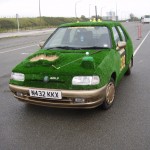
A BMW painted up as a fire engine, with a hydrant connection on the bonnet.
A Daihatsu with a solar cell on the bonnet and wind generator attached to the roof.
A Lexus 400 with a second roof suspended above the original one, in defiance of the organisers' ruling that the roof must not be cut off.
However, looking at the cars, it was difficult to believe that some of them had been bought for £150. Many of the occupants were dressed to match the theme of their vehicles, and it was clear that we had not entered into the spirit of the event to the same extent as some other people. We could not make any serious cosmetic changes to our car because there was already a buyer lined up for it if it survived intact.
After a loud blast on a horn we set off, and as we left the car park we were given details of the first challenge, which was to photograph certain buildings at the former Grand Prix circuit near Reims, which we were expected to reach at about midday. It goes without saying that there was some commotion as 60 cars drove through the town to the autoroute.
 We were allowed to take any route we liked, but the time schedule dictated that we used the autoroute, especially as the weather was bad, with heavy rain. At times it was so bad that it was difficult to see much at all through the spray when overtaking the lorries. By midday we were near the meeting place for the challenge when we took a wrong turning in some road works on the autoroute and finished up going 14 miles to the next exit before we could turn back. Now, I am not going to say whose fault this was, but as team leader I realise that I have no alternative but to accept ultimate responsibility for mistakes made by any member of my team. Anyway, we decided that we had lost so much time that it would be best to miss out the challenge and press on. The same thing actually happened to several other Czechwrecks teams.
We were allowed to take any route we liked, but the time schedule dictated that we used the autoroute, especially as the weather was bad, with heavy rain. At times it was so bad that it was difficult to see much at all through the spray when overtaking the lorries. By midday we were near the meeting place for the challenge when we took a wrong turning in some road works on the autoroute and finished up going 14 miles to the next exit before we could turn back. Now, I am not going to say whose fault this was, but as team leader I realise that I have no alternative but to accept ultimate responsibility for mistakes made by any member of my team. Anyway, we decided that we had lost so much time that it would be best to miss out the challenge and press on. The same thing actually happened to several other Czechwrecks teams.
The weather continued to be bad, and on both sides of the Swiss border we ran into typical Friday evening traffic which was very slow going, but we arrived in Interlaken at 8.15 and went straight to the hotel. This turned out to be very, very, Swiss, and I had a quaint little 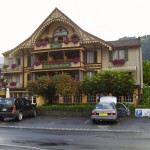 room with a balcony inside a large fretwork structure on the front of the building, so that it was just like being inside a cuckoo clock. Fortunately Steve had a more conventional room, because he would hardly have been able to stand up in mine.
room with a balcony inside a large fretwork structure on the front of the building, so that it was just like being inside a cuckoo clock. Fortunately Steve had a more conventional room, because he would hardly have been able to stand up in mine.
We walked down to the meeting place in the town, and saw a number of other Czechwrecks cars on the way, including the Triumph Herald. On the autoroute we had thought about them, with their 1960s windscreen wipers, and they did extremely well to get to Interlaken in the time, especially considering that they completed the challenge at the Reims circuit. When we reported to the organisers at 9.30 they said only 20 teams had turned up so far. We had covered almost 600 miles in the day.
Day 2. Saturday 28th August. Interlaken to Bormio, Italy.
 The meeting place was a large car park near the river, and our initial impression was that there were noticeably fewer cars than at Calais. There were stories of people arriving at 1.30am after all sorts of problems, but most teams seemed to be in good spirits. The challenge for the day was to obtain 7 photographs of cars in various colours, with less common colours such as brown and pink scoring more points than black or blue.
The meeting place was a large car park near the river, and our initial impression was that there were noticeably fewer cars than at Calais. There were stories of people arriving at 1.30am after all sorts of problems, but most teams seemed to be in good spirits. The challenge for the day was to obtain 7 photographs of cars in various colours, with less common colours such as brown and pink scoring more points than black or blue.
We set off with Steve driving, on a route taking us over the Susten Pass, which is one of the longest and the first real test for the car. It was still raining most of the time, which perhaps helped to keep things cool as we went through Andermatt and on to the Oberalp Pass. After the lunch stop at Chur I took over for the drive to Bormio via the Julier Pass, St.Moritz, Bernina Pass, Livigno, and a couple of other smaller passes. The car performed superbly, as I thought I did, although Steve got a bit worried about the smell of brake linings on the Julier Pass. Along the way we saw a few other teams, but in general the roads were not busy and we were able to set our own pace. The scenery was fantastic, although at times we could not see much because of the rain and low cloud.
although Steve got a bit worried about the smell of brake linings on the Julier Pass. Along the way we saw a few other teams, but in general the roads were not busy and we were able to set our own pace. The scenery was fantastic, although at times we could not see much because of the rain and low cloud.
Shortly before the Italian border we were overtaken on a hairpin bend by the Goat, a Fiat van containing the organisers of the event. At the customs post they were two places in the queue in front of us, and it was with some satisfaction that we saw them taken to one side and searched as we drove away.
This was my first visit to Italy since about 1974, and Bormio is a very upmarket and smart place, nothing like the Italy that I remembered. The evening meeting place in the town centre had been changed and all entrants were supposed to have been advised by text but many people including ourselves did not get the message. However, we eventually found the organisers and other teams in a café. It was always difficult to know how many people had had problems, and we had not actually seen any cars in trouble, but there were plenty of stories. One lad of about 20 came over to talk to us. It was his first sight of Switzerland and he was very excited. There were three of them in a Cavalier, and they had slept the previous night in the car, which took me back to my first trip to Switzerland at the same age in a Singer Roadster with no hood and sleeping under a polythene sheet.
By the end of the day we had actually got some photos for the challenge, including a brown car and a pink one. Pink is not very popular in Switzerland, probably because there are no bank notes in that colour.
Day 3. Sunday 29th August. Bormio to Salzburg, Austria.
 This started with the event that we had been dreading - a group photograph with everyone dressed as nuns. A couple of weeks before the rally I had managed to procure two cut-price nun's costumes from a party shop in Bognor, one medium and one large. When I got home I found that they were described as Adult Female Nun's Costumes, and was going to take them back and change them for Adult Male Nun's Costumes, but then realised that the shop probably wouldn't have any.
This started with the event that we had been dreading - a group photograph with everyone dressed as nuns. A couple of weeks before the rally I had managed to procure two cut-price nun's costumes from a party shop in Bognor, one medium and one large. When I got home I found that they were described as Adult Female Nun's Costumes, and was going to take them back and change them for Adult Male Nun's Costumes, but then realised that the shop probably wouldn't have any.
The meeting place was in a car park adjacent to a motor caravan overnight parking area, the occupants of which seemed somewhat surprised to wake up finding themselves faced with a large number of nuns, most of them rather obviously male. The group photograph was followed by a water pistol fight which Steve and I did not take part in, but I captured on video, dodging about the whole time to keep the camera dry. The challenge for the day was a rather complicated set up, in which team members had to be photographed in nun's costumes in groups including members of the public, the larger the group, the higher the score.
At 10.00am we left, to tackle the nearby Stelvio Pass, which was the most challenging one in the event. The weather had improved at 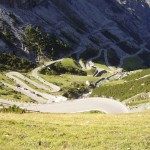 last, but there was more traffic and the climb to the summit was quite slow. There was a break at the summit for a "photo opportunity" and coffee. On the descent the road was clearer, but Steve kept in second gear to spare the brakes, partly I think as an example to me, as he thought I had over-cooked them a bit the day before. As it was around Sunday lunchtime there were a lot of motorcycles and a fair number of hardy souls on bicycles making their way over the pass.
last, but there was more traffic and the climb to the summit was quite slow. There was a break at the summit for a "photo opportunity" and coffee. On the descent the road was clearer, but Steve kept in second gear to spare the brakes, partly I think as an example to me, as he thought I had over-cooked them a bit the day before. As it was around Sunday lunchtime there were a lot of motorcycles and a fair number of hardy souls on bicycles making their way over the pass.
After the Reschen Pass I took over for the comparatively easy drive to Salzburg, mainly on the autobahn. Rather strangely this road runs through Germany for some distance before re-entering Austria. Steve very kindly agreed to allow me to divert a few miles off the route to go up to Oberau, a ski resort that I have visited for over 40 years, but there was no one about at the hotel where my friends and I always stay.
The Hotel Turnerwirt in Salzburg was about 2km from the city centre, but we decided to walk to the evening venue for the exercise. There were quite a lot of Czechwrecks cars around, but it was impossible to tell how many teams had actually arrived. Salzburg seemed very different from how I remembered it from my last visit about 40 years ago, and I can only think there were parts of the city that we did not see on this trip.
Day 4. Monday 30th August. Salzburg to Prague, Czech Republic.
 We were given a map the previous evening showing the meeting place, which was described as a disused bus lane alongside the river near the city centre. Shortly after we joined the line of parked cars someone discovered that the bus lane was not disused, and we were quickly handed the challenge sheet and told to go before we got booked.
We were given a map the previous evening showing the meeting place, which was described as a disused bus lane alongside the river near the city centre. Shortly after we joined the line of parked cars someone discovered that the bus lane was not disused, and we were quickly handed the challenge sheet and told to go before we got booked.
This was Old Car Day, and the challenge was to photograph the oldest car we could find, subject to various conditions, the winning team being the one with the photo of the oldest car.
We could choose any route we liked to Prague, and we decided to take the most direct way over ordinary roads via Schäding, because Steve had ridden it previously on motorcycle tours. It was raining yet again and it was on this stretch that we had the most exciting incident of the whole rally.
As we came out of a village Steve glimpsed an old car in the garden of a house and we decided to turn back to look at it. Now, I am not going to say who was driving, but it wasn't me. We travelled rather fast downhill towards a side turning on the left and the driver left the braking a bit too late, so that we turned into the side road with the front wheels locked on loose gravel, sliding relentlessly towards a fence, on the other side of which the ground dropped down into a grassy field. My whole life passed in front of me as I gripped the dashboard with white knuckles, and I breathed a sigh of relief as the car shuddered to a halt a few inches short of the fence.
There is a certain amount of artistic licence in the foregoing description, but it was quite exciting at the time. Upon closer inspection the old car in the garden wasn't old enough to be worth crashing for.
Until now we had used the satnav with great success, but it did not have a program for the Czech Republic. At the Czech border we stopped for a snack, bought a good street map of Prague and I took over the driving. This was my first visit to the Czech Republic and the roads were much better than I had expected, certainly better than some other East European countries.
Our hotel was on the opposite side of Prague to where we came in, and somehow Steve managed to guide us there through heavy traffic on the complicated road system. Without the map it would have been impossible. We decided to go to the evening meeting place at the George and Dragon pub in the city centre by Metro, as it was only 5 stops and we had had enough of the traffic.
When we got there we were surprised how many teams were there, nearly everybody it seemed. Obviously we were not in the running for an award, as we had performed miserably in the challenges, but 2 teams received very well-deserved prizes. One was the Triumph Herald, and the other a small car called Little Eric, driven by a mature couple. It had belonged to a friend named Eric who had died of leukaemia, and was abandoned, flooded, some time before his death. They saved it from being scrapped, got it running and drove it to Prague with sponsorship for a leukaemia charity.
At the start we had not been sure what to expect from the other teams, but we did not see any bad conduct at all. In the initial instructions the organisers had warned very strongly about speeding and reckless driving, and the majority of people stuck to the rules.
In an event like Czechwrecks different teams have very different experiences. Steve and I did not find it very demanding, because we were two people staying in hotels and travelling in a large, fairly powerful and ultimately totally reliable car. Four people in a small, unreliable car having to put tents up every night would be stretched to complete the rally, if they could do so at all. The reliability of the car is the most critical factor and it is a tribute to Steve's thorough preparation that we had no problems.
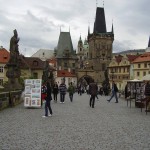 After the rally we stayed for an extra day in Prague, and I have to say that I was extremely impressed with the city. The next morning we visited the excellent Skoda Museum in Mladá Boleslav, about 35 miles away, and in the afternoon we went on a guided tour of the nuclear bunker in Prague, now used mainly as a music venue. As part of the fun we tried on some sticky rubber gas masks that had been worn by several thousand other people, and the next morning I woke up to find a couple of sore spots on my face.
After the rally we stayed for an extra day in Prague, and I have to say that I was extremely impressed with the city. The next morning we visited the excellent Skoda Museum in Mladá Boleslav, about 35 miles away, and in the afternoon we went on a guided tour of the nuclear bunker in Prague, now used mainly as a music venue. As part of the fun we tried on some sticky rubber gas masks that had been worn by several thousand other people, and the next morning I woke up to find a couple of sore spots on my face.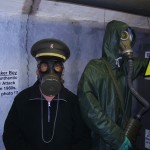
On the way back into Prague from Mladá Boleslav we encountered an extraordinary wall of near stationary lorries on the inside lane of the 3-lane dual carriageway leading into the city, stretching for miles from the city boundary to well past the city centre. It was impossible to see any signs or exits, and we finished up going miles out of way to get back to the hotel.
From Prague we drove straight across Germany and shortly after the border we came up behind a black Audi on the autobahn, and a sign appeared in the rear window BITTE FOLGEN - POLIZEI. They led us into a service area and one of the officers, who were both in very plain clothes, said they were carrying out a check. I decided not to disclose that I could speak German and left Steve, who was driving, to deal with them. One of them asked to see in the boot, pointed to my large silver wheelie case and said "Guns, knives, drugs?". Not surprisingly, Steve said "No" and they did not pursue the matter further. However they took our passports and car documents to their car and it was about ten minutes before one of them gave everything back to Steve and said "You can go now". Steve said the man looked annoyed because they had been unable to find anything wrong.
In Germany we spent a day at the vast Sinsheim Technical Museum and in Belgium called in at the Spa-Francorchamps Motor Racing Circuit museum. On the final day, before catching the ferry, we went to the museums at La Coupole and Le Blockhaus, two proposed German V1 and V2 assembly sites near St.Omer, which fortunately were put out of action by the RAF before they were able to produce any weapons.
When we got back to my house the car was still running perfectly after travelling over 2400 miles, and it has now gone on to the new owner as planned. Before the event some our mutual friends forecast that Steve and I would fall out, which did not happen, but whether we shall do any more rallies like this remains to be seen. CzeckWrecks 2010 was certainly good fun, and at the time of writing a slide show of hundreds of photographs of the event can be found on www.streetsafari.com. Our car is the silver Ford Sierra Sapphire G890 GCL.
Russia 2010
St.Petersburg, Moscow, and places in between.
Many British people go to Russia nowadays, mainly on organised tours to St.Petersburg and/or Moscow. Independent travel is still fairly unusual, and having done it, I now know why. The aim of my brief visit was to find out what Russia is like, not the art galleries and museums, but the country. This is, of course, impossible. Russia is the largest country in the world, larger than Western Europe and the USA put together, with a 10-hour time difference from west to east and including many different cultures. In recent times the country has changed so fast that it is actually quite difficult to find out what it is really like without going there. Probably the best sources of information about Russia, past and present, are the Lonely Planet and Rough guides and Jonathan Dimbleby's book (based on the BBC TV series) "Russia, a Journey to the Heart of a Land and its People". He travelled in stages from Murmansk in the north to the far south, and then across to Vladivostok in the east, a total distance of 10,000 miles in 18 weeks.
My plan, in 9 days, was to fly to St.Petersburg and drive to Moscow and back, 450 miles each way, looking at large towns, small towns, villages and anything else that caught my interest on the way. Driving in Russia was likely to be exciting. Jonathan Dimbleby said that of the 80 countries he had driven in Russia was the one in which he felt most insecure, and before going he was given advice by an ex-SAS medical orderly who described the lurid consequences of a head on collision. Heads could be severed and hurled around the inside of a vehicle like clothes in a washing machine. Russian drivers had a rather perverse motto 'Die today because tomorrow you might live', but I still didn't think it could be worse than Albania.
Visa traumas
To go to Russia you have to a have a visa, and to get a visa you have to have an "invitation". Most people get their visas through their tour organisers, and have little idea of the procedure involved. If you don't have a tour organiser you have to get an invitation from an approved travel organisation with links to Russia, but it is really just a formality and a way of spending some money. I got my invitation on the internet through a firm called Real Russia, which has offices in London, St.Petersburg and Moscow. They will also arrange to get your visa for an extra fee, but I decided to do it myself, which may not have been very wise. The Russian embassy has sub-contracted its visa service to a private company, and you have to fill in the form on line. To do this you need a degree in Information Technology with ancillary Convoluted Thinking, and after about 2 hours I was on the point of giving up when it suddenly went through. I sent my passport to the Russian embassy with the printed-out form and it came back after a few days with the visa. The cost altogether was around £100.
Needless to say, it is not as simple as that because when you get to Russia you have to register your visa within 3 working days of arrival to give the authorities some degree of information about your movements within the country. The rules relating to visa registration are quite complicated and often poorly explained in guide books. If you are staying in a hotel the hotel should register your visa, but some cheap hotels make a charge or even refuse to do it. A lot of guide books say you must get your visa stamped every time it is registered but that system finished in 2007 and the hotel should now give you a standard form to prove your registration.
In fact, all the hotels I went to kept my passport for up to an hour after my arrival to register my visa, but only one gave me the proper form. When I raised this with a couple of the others they said "It's in the computer", and told me to show the police my payment receipt or room card if I was stopped.
If your visa expires while you are in Russia it can be a massive problem, because you cannot get accommodation without a valid visa, and might face a fine on leaving the country as well as difficulty in getting a visa in the future. Tourists whose visas expired while they were delayed due to the Icelandic volcano were ordered to remain in their hotels until they had new flights arranged, and that would obviously be difficult for an independent traveller. When I applied for my visa no one had thought of the volcano, and I only allowed 2 extra days beyond my return flight, but if the volcano blew up again I had a contingency plan to jump on a train to Tallinn in Estonia while my visit was still valid.
St.Petersburg
The flight to St.Petersburg was with Lufthansa via Dusseldorf, where I experienced the most stunning example of German inefficiency that it is possible to imagine. After going through immigration three times due to a last minute unannounced gate change I was the last person on the plane, which did not make me very popular, as it had been waiting 25 min.
At Pulkovo 2 airport in St.Petersburg there was a massive and badly organised immigration queue, and it took about an hour to get through, but the actual procedure for most people was quite quick, with no fingerprinting or other time-consuming checks.
When I came out of the terminal and looked around I was more fazed than I have ever been in any such situation before. Apart from a couple of advertising slogans, everything in sight was in Cyrillic characters. Now, this was Russia, and I suppose I should not have been surprised, but I was. When I was planning the trip I thought it might be useful to learn the Cyrillic alphabet, but I did not realise that for travelling around it would be essential. I had learnt to recognise the characters, but not most of the sounds associated with them, which made it difficult to memorise words.
Public transport from the airport to the city centre consists of a bus or mini-bus to Moskovskaya Metro (underground) station and then on by Metro. There was no sign of a bus, but a continuous supply of yellow mini-buses with the names of their stopping places in the window in Russian. I let the first one go, thinking it was a pirate taxi. After studying the list of stops on the next mini-bus I realised that Московская was Moskovskaya and got in. I paid the driver when everyone else did and just hoped I would know when to get off. In fact, the driver announced Moskovskaya very loudly when we reached the Metro station.
On the Metro there is a flat fare of 26r per journey, regardless of where you go, and in return for the money you receive a metal token. This sounds straightforward, but wasn't, and by the time I had got my token the lady in the ticket office didn't seem to like me very much. To complicate things my wheelie case was too big to go through the automatic gates, and a man came out of a little cabin shouting "Plastik, Plastik". It turned out that if you had a large item of luggage you had to have a plastic token that would open the wide gate at the end. This meant that I had to fight my way back against the crowd to the lady who didn't like me very much and ask for a plastic token instead of the metal one, causing her to like me even less. Russians are big robust people, and when they are in a hurry and you are in the way they let you know it.
Eventually I got to the platform, which was like an airport shuttle station, with a row of doors that open matching those on the train. I had to go 5 stops on one line and 3 stops on another, starting at Moskovskaya (Московская) and finishing at Mayakovskaya (Маяковская). This sort of thing is done, of course, quite deliberately to confuse foreigners. There were no station names visible from on the train, just a single, muffled announcement in Russian, so all I could do was count the stops and hope I had got it right. At the intermediate station, Tekhnologichesky Institut, I got out and was completely at a loss as to how to find the train to Mayakovskaya. After asking several people and getting nowhere I found a very nice young lady who spoke good English and was going to Mayakovskaya. This seemed too good to be true, but I suppose something had to go right, and when we got off the train she pointed me in the direction of my hotel.
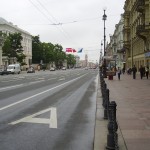 As always, I had booked the hotel on the internet and, as always, had chosen one of the cheaper ones, called Rinaldi at Nevski 105. Nevski Prospekt is the main thoroughfare in St.Petersburg and perhaps the most the most famous street in the whole of Russia. Most of it is very wide and lined with quality hotels and the big names from the purveyors of fine goods to the upper classes. My hotel was in the other part of Nevski Prospekt, on the downwind side of the railway station, and it proved to be rather hard to find. After a lot of confusion involving several helpful people it turned out that the hotel was in a yard like a mews behind no.105, and the entrance was a solid steel door with Rinaldi on a brass plate, and a numeric key pad underneath. All attempts at pressing buttons failed, until another helpful person rang the phone number on my booking confirmation and spoke to someone in the hotel. The number 2006 was given, and when put into the key pad the door clicked open. I thanked the helper and went in, to find myself facing 3 flights of crumbling shallow stone steps surrounded by peeling paint. This place had obviously not changed one iota since the Siege of Leningrad in 1941. On the first floor was another steel door with a bell push, which when pressed produced a muffled woman's voice saying something in Russian. All very John le Carré. I said my name and when the buzzer sounded I went through to find an immaculate and modern reception desk with a lady who spoke excellent English. It turned out that she taught English in a school some distance away, and was moonlighting (her word) during the holidays.
As always, I had booked the hotel on the internet and, as always, had chosen one of the cheaper ones, called Rinaldi at Nevski 105. Nevski Prospekt is the main thoroughfare in St.Petersburg and perhaps the most the most famous street in the whole of Russia. Most of it is very wide and lined with quality hotels and the big names from the purveyors of fine goods to the upper classes. My hotel was in the other part of Nevski Prospekt, on the downwind side of the railway station, and it proved to be rather hard to find. After a lot of confusion involving several helpful people it turned out that the hotel was in a yard like a mews behind no.105, and the entrance was a solid steel door with Rinaldi on a brass plate, and a numeric key pad underneath. All attempts at pressing buttons failed, until another helpful person rang the phone number on my booking confirmation and spoke to someone in the hotel. The number 2006 was given, and when put into the key pad the door clicked open. I thanked the helper and went in, to find myself facing 3 flights of crumbling shallow stone steps surrounded by peeling paint. This place had obviously not changed one iota since the Siege of Leningrad in 1941. On the first floor was another steel door with a bell push, which when pressed produced a muffled woman's voice saying something in Russian. All very John le Carré. I said my name and when the buzzer sounded I went through to find an immaculate and modern reception desk with a lady who spoke excellent English. It turned out that she taught English in a school some distance away, and was moonlighting (her word) during the holidays.
When I got sorted I went for a walk along Nevski Prospekt. It was Saturday evening and very busy, with a lot of people around including a considerable number in smart military uniforms. The traffic travelled at astonishing speeds in the stretches between the traffic lights, 50 or 60mph being not uncommon, and the many police, mainly in cars, did not take much notice. I was too tired to walk far, and on the way back I stopped at a fast food place for a 'large' jacket potato with a cheese filling. This was where I discovered that in Russia food portions are significantly smaller than in Britain, and downright tiny compared with the USA. The same applied to restaurant meals that I had subsequently, though the international standard hotels used by the tour companies would probably be more in line with western practice.
The hotel breakfast the next morning was unusual in that most of it came in a sealed paper bag, supplied by an outside firm like an airline meal. The main item was a packet of porridge, which the lady took and returned with hot milk added. There were also sachets of tea and coffee, butter, cheese, honey and various other bits and pieces. Toast came separately.
 After breakfast I set off in the rain to look at St.Petersburg. As I said at the start, museums and art galleries are not my scene, and they are the subject of literally dozens of books and web sites that will leave you more breathless with wonder than any description that I could possibly provide. It was Peter the Great's intention to create a showpiece to impress the world with Russia's wealth and cultural achievements, and he undoubtedly succeeded in doing that, although it was at a high price in terms of human suffering. In the morning I decided to follow the Lonely Planet guide's walking tour of the Historic Centre, which takes in all the main sights, and gave myself a crash course in Cyrillic pronunciation on the way. With a population of 4.6 million St.Petersburg is a large city and has all the usual problems of such, but the famous historic area is actually quite small and has a concentration of stunning architecture that is probably unequalled anywhere.
After breakfast I set off in the rain to look at St.Petersburg. As I said at the start, museums and art galleries are not my scene, and they are the subject of literally dozens of books and web sites that will leave you more breathless with wonder than any description that I could possibly provide. It was Peter the Great's intention to create a showpiece to impress the world with Russia's wealth and cultural achievements, and he undoubtedly succeeded in doing that, although it was at a high price in terms of human suffering. In the morning I decided to follow the Lonely Planet guide's walking tour of the Historic Centre, which takes in all the main sights, and gave myself a crash course in Cyrillic pronunciation on the way. With a population of 4.6 million St.Petersburg is a large city and has all the usual problems of such, but the famous historic area is actually quite small and has a concentration of stunning architecture that is probably unequalled anywhere.
After 2 or 3 hours of this I decided to move into the real world and look at the Apraksin Dvor Market, which is sadly in the process of 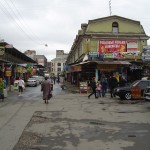 being revamped and turned into another modern shopping mall. This is a proper market where local people and tourists do their shopping amongst decaying buildings that apparently offend the sensibilities of the city fathers and also provide an opportunity for vast sums of money to change hands in the name of urban regeneration.
being revamped and turned into another modern shopping mall. This is a proper market where local people and tourists do their shopping amongst decaying buildings that apparently offend the sensibilities of the city fathers and also provide an opportunity for vast sums of money to change hands in the name of urban regeneration.
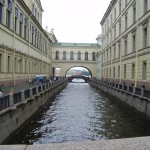 St.Petersburg has miles of canals, lined with fine buildings, including many of the major sights. In the afternoon I went on a one-hour canal boat tour with a commentary only in Russian. The lady in charge came round to collect the money before the boat set off, to ensure that she had got it before the passengers sitting outside were decapitated by the first low bridge.
St.Petersburg has miles of canals, lined with fine buildings, including many of the major sights. In the afternoon I went on a one-hour canal boat tour with a commentary only in Russian. The lady in charge came round to collect the money before the boat set off, to ensure that she had got it before the passengers sitting outside were decapitated by the first low bridge.
The next morning I set off for the airport to collect my car. By now I had realised that everything in Russia was more difficult than I could imagine, and that included finding the way into the Metro station. While I was searching around a little old lady came along with a big shopping bag in one hand and a bunch of flowers in the other. She wanted to help, so I somehow explained what I was trying to do, and she marched up to the OUT doors, forcing them back into the faces of the people trying to come through. When they complained she shouted at them and then at me for lagging behind as I struggled with my large wheelie case. This was repeated at another set of doors, and we emerged on the other side of the building, where she took me round to the entrance. Just one example of so many on this trip where people offered to help, and if anyone imagines that ordinary Russians are afraid of foreigners they could not be more wrong. Amazingly, the flowers survived.
At the airport I was not at all surprised to find that the Hertz Car Rental desk was unattended. I was supposed to collect the car at 11.00am, and by 11.15 there was still no one there. I asked the lady on the City Information desk opposite, and she offered to ring the number on my reservation form. The man who answered spoke good English, and said he would be outside in 3 minutes in a VW Transporter. Five minutes later a VW Transporter arrived driven by a extremely smart young man wearing a special Hertz tie that would be clearly visible from Outer Space, and he took me to their depot in an underground car park in the Trade Centre about ¼ mile away. It seemed to be taken for granted that somehow their customers would track them down, but it would have been so much easier with a notice on the airport desk explaining the situation and giving the phone number. I came across this kind of thing time and time again in Russia, and there seems to be a reluctance to put up signs or notices in any language providing essential information for strangers. Perhaps it goes back to the Soviet days and a desire to keep things secret.
On the road at last
The car was s Skoda Octavia with 290km on the clock from new. I would have preferred a proper Russian car like a Lada or Volga, but they are not reliable enough for the international rental firms. The next task was getting petrol, as the tank was almost empty, and that proved as difficult as everything else in Russia. You have to pay in advance (as in many other countries, including the USA nowadays) which was manageable, and the price was equivalent to about 60p per litre, far cheaper than at home. Making the pump work was another matter, and by the time I had finished messing about I had just about brought the whole place to a standstill. A lady came from the office and pointed out that there were 2 different types of 95 octane, and I had chosen the wrong one. I could only think one was leaded and the other unleaded. The lowest grade was 72 octane, and I can't imagine what you would put that in.
From St.Petersburg to Moscow is about 450 miles and there is only one direct road, the M10 'motorway'. My night stop was to be Novgorod, about 110 miles on the M10, but in this case there was an alternative route via the M20 motorway to a town called Luga and then an ordinary main road across country to Novgorod. This way was about 25 miles further, but looked more interesting.
The M20 was a rude awakening to Russian driving. At the start it was being upgraded and there were acres of tarmac with no markings at all, so you had to guess where the lanes were, which made no difference to the local drivers at all. After some distance it degenerated into a 2-lane single carriageway similar to an ordinary main road in Britain, and it was like that most of the way to Luga, a distance of about 70 miles. There was very heavy traffic, largely lorries, but I must admit that after a short time I started to drive like a Russian, overtaking with abandon in the face of oncoming traffic.
Luga is by-passed, and quite a pleasant little town, with tree-lined roads and a market, and I turned off here on to the P47 to Novgorod. 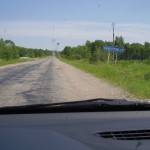 The first 40 miles was an old concrete road that was rather like a net, entirely covered with pot holes a few inches across. At 40 - 50 mph the car just thumped along, and there was no other traffic apart from an endless number of orange Kamaz (or Kamaз) trucks, carrying aggregates from a quarry.
The first 40 miles was an old concrete road that was rather like a net, entirely covered with pot holes a few inches across. At 40 - 50 mph the car just thumped along, and there was no other traffic apart from an endless number of orange Kamaz (or Kamaз) trucks, carrying aggregates from a quarry.
Novgorod
Now, we are talking here about Velikij Novgorod, not the much larger industrial city of Niznij Novogorod, about 400km east of Moscow. Velikij Novgorod, usually just known as Novgorod, is an old city in origin, much older than St.Petersburg, and was at one time the effective capital of Russia. Before the Second World War it had some fine buildings, but was almost entirely flattened by Hitler, though some of it was rebuilt in something like the original style.
Unfortunately, when they rebuilt it they didn't put the names back on the streets, which caused a considerable problem to me when I arrived. I had booked a room at the Hotel Intourist, described by the LP guide as "this old Soviet stalwart", which sounded ideal. Intourist was the name of the state travel organisation during Soviet times, which controlled the movements of all tourists in Russia. Once I realised that I was definitely lost, which didn't take long, I stopped in the entrance to an industrial site and asked a young bloke who had his head stuck under the bonnet of an old Lada. He did not know where the hotel was, and his very fed-up looking female companion did not know either. I would imagine that the female companions of the owners of old Ladas are fed-up a fair amount of the time. After a lot of consideration he rang the hotel on his mobile and they told him where they were. He indicated that I should follow him, and once he had got the car sorted we set off on a nerve-wracking drive through the rush-hour traffic. In a few minutes we arrived at the Intourist, and I thanked him profusely, something that I seemed to spend a lot of time doing in Russia.
The Intourist had a huge mural of Mother Russia above the entrance, a relic of Soviet times, but had pleasant English-speaking staff and was actually quite all right. Once I got my passport back after the visa registration ceremony I set off on foot to look round the town and get something to eat. Almost next to the Intourist was a wonderful example of post-war modernist architecture in the form of a theatre 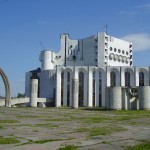 built of concrete with white marble cladding. Much of the marble has gone, taken, I understand, by local people for home improvement, but the general style of the building could perhaps best be described as interesting. Apparently it was designed by three architects, and one might be forgiven for thinking that they had no communication with one another.
built of concrete with white marble cladding. Much of the marble has gone, taken, I understand, by local people for home improvement, but the general style of the building could perhaps best be described as interesting. Apparently it was designed by three architects, and one might be forgiven for thinking that they had no communication with one another.
The weather was very hot and somehow I missed the road that led to the city centre, with the result that I was almost dying of exhaustion when I finally found a restaurant. The staff did not speak English, there was no English menu, and in fact I got the impression that I was the first foreign customer they had ever had. Eventually it was agreed that I would have shashlik because it was the only dish known to everyone involved, and it turned out to be quite a good meal.
Suitably refreshed I retraced my steps as far as the river and came across the World War II Monument, which has a kind of stark, brutal,  hardness that could only be Russian. Nearby was a beach, crowded on a warm evening, and next to it the Kremlin. Kremlins are not unique to Moscow, as the word means fortress. Although it dates back to the 14th century I found it rather disappointing, but in the middle is the Millennium Monument, a 19th century sculpture 16m high, incorporating 129 figures of notable Russians. Hitler ordered it to be taken to Germany and had it cut up for transport, but fortunately the Germans were kicked out before they had time to move it.
hardness that could only be Russian. Nearby was a beach, crowded on a warm evening, and next to it the Kremlin. Kremlins are not unique to Moscow, as the word means fortress. Although it dates back to the 14th century I found it rather disappointing, but in the middle is the Millennium Monument, a 19th century sculpture 16m high, incorporating 129 figures of notable Russians. Hitler ordered it to be taken to Germany and had it cut up for transport, but fortunately the Germans were kicked out before they had time to move it.
In St.Petersburg I had noticed that the traffic noise seemed to go on all night, and it was the same in Novgorod. As the days passed on this trip I realised that the Russians, like the Americans, never seem to sleep, and many businesses are open 24 hours, which I found quite surprising. There is also less Sunday observance than in Britain or many other western countries.
The M10 to Vyšnij Voloček and Tver
After a comprehensive but uninspiring buffet breakfast I set off for the long journey on the M10 'motorway' to Tver, a town about 100 miles north of Moscow, intending to stop on the way at Vyšnij Voloček, reputedly once known as the Russian Venice.
The M10 is, I suppose, the most important road in Russia, linking the two largest and most influential cities. It actually by-passes Novgorod and it takes about 25 miles to get to the motorway, which at this point has been upgraded to a very high standard, similar to a British one. However, I was rather astonished to come across several uncontrolled pedestrian crossings, just marked with stripes and a small gap in the central barrier. This would be like having a pedestrian crossing on the M1 in England, and I would think the consequences of using them would be the same. After some distance the road went down to a 3-lane single carriageway with the centre lane used for short distances for overtaking by traffic travelling in one direction and then the other, an arrangement that was used in Britain in the 1950s and 60s on trunk roads like the A5 and A20. This set up continued most of the way to Tver, and as I hurtled along the centre lane between the lines of lorries travelling in opposite directions, just managing to get in before the arrows at the end, Jonathan Dimbleby's severed heads were never far from my mind. I think many drivers brought up in the dumbed-down highly regulated driving environment in Britain today would find this quite difficult.
The road passed through a lot of villages along the way, lined with old detached wooden houses that were exactly how I expected dachas to be. At one time this road would have been the village street, but nowadays it is so busy and difficult to cross that the communities are effectively cut in half. Between the name signs at the start and end of the residential areas the urban speed limit of 60kph (37mph) applies, and there are occasional uncontrolled pedestrian crossings, but few people slow down and to stop at a crossing would be courting disaster, because no one is expected to. In one place I saw a little girl of about 10 run across through fast-moving traffic, followed by a loose dog. Miraculously both survived. Police speed traps are frequent, but can usually be seen from some distance away.
The road is reasonably well surfaced, but one stretch, on the approach to a bridge, it was so bad that the traffic slowed to walking pace for two or three hundred yards as the lorries lurched over mounds of uneven tarmac. Not long after leaving Novgorod, on one of the better parts of the motorway I heard a loud bang from something hitting the car, but could not see any damage.
The M10 actually runs right through Vyšnij Voloček, and during the day there is a queue of traffic several miles long both sides of the town, but I turned off and found what is in effect the town centre, some way from the main road.
 Now Vyšnij Voloček is actually my sort of place and I think I would be quite happy living there. It is a complete mess, with largely unmade roads, a scruffy but lively market and seemingly few rules and regulations about anything. I saw a couple of overgrown canals, but it must have gone downhill a long way for someone to have made the comparison with Venice.
Now Vyšnij Voloček is actually my sort of place and I think I would be quite happy living there. It is a complete mess, with largely unmade roads, a scruffy but lively market and seemingly few rules and regulations about anything. I saw a couple of overgrown canals, but it must have gone downhill a long way for someone to have made the comparison with Venice.
Tver is an entirely different matter. With a lot of fine buildings and the River Volga running through the middle of it, it has been described as being like a little St.Petersburg, and that is quite appropriate. I had a reservation in a hotel called the Seliger near the centre, and it was actually not too difficult to find. It surpassed all expectation in having no English-speaking staff, and I don't how I got past the ground-floor reception, but I eventually got to my room on the second floor. At the top of the stairs was another receptionist who gave me my key, and there were two other people whose roles were uncertain. One was an elderly man who sat near the receptionist, and the other a lady at a desk at the far end of the corridor just past my room. In Russia there seem to be quite a lot of people around in non-jobs which date back to Soviet times. There is a general rule that you should not drink the tap water in Russia. In St.Petersburg it is supposed to contain some sort of invisible bug, but in Tver the deficiencies were not invisible. When I ran the tap in my room the water came out brown, and the lavatory looked much the same after flushing as it did before. I discovered this just after having a shower.
The hotel car park was actually an independent car park at the back, run by a man who had what I could best describe as a "can't do" attitude that I came across many times in Russia, especially in older people with service jobs. His first reaction to my car appearing on his territory was to try to stop me parking there. After a bit of an argument in which I spoke English and he spoke Russian he agreed that I could park there for the night for 200r (about £5).
 Tver is a lively and generally quite tidy town with a population of 450,000, and a comprehensive but extremely worn out public transport system. There are trams, trolley buses, buses, mini buses and taxis, but most of the trams and some of the buses are quite literally falling to pieces. It had been a long day, and after a meal and a walk round the town centre I retired early.
Tver is a lively and generally quite tidy town with a population of 450,000, and a comprehensive but extremely worn out public transport system. There are trams, trolley buses, buses, mini buses and taxis, but most of the trams and some of the buses are quite literally falling to pieces. It had been a long day, and after a meal and a walk round the town centre I retired early.
The next morning when I went out to the car I discovered the cause of the bang I had heard on the motorway. On the passenger's side of the windscreen was a star-shaped crack about 1½ inches across with traces of stone in the middle. I was concerned about this partly because I thought it might get worse with the stresses on the windscreen on the bad roads, and also because I knew I would have to pay for it, as windscreens are never normally covered by rental car insurance.
The route from Tver to my hotel on the outskirts of Moscow was just over 100 miles, and did not look too difficult on the map. It was so-called motorway almost all the way, and in my mind I thought it would take about 2 hours. In reality it turned into the most stressful drive I have ever had, with 4½ hours of dreadful traffic, and I can only say that if you are ever thinking of driving into Moscow, don't. To get to my hotel I had to take the ring road, which is very similar to the M25, and has the same sort of problems. As the M10 approached the ring road there was a massive traffic hold-up which unleashed the sort of driving that I had only seen in Albania, where people drive on every available piece of land to try to get past the stationary traffic. In one place vehicles, including a large Sprinter van, drove down a grass bank, along a narrow footpath and then scrambled back up another grass bank and pushed their way into the queue in front. Strangely, this did not seem to cause road rage.
The ring road was a nightmare, with several stretches of very slow-moving traffic caused by broken down cars (usually beaten-up old Ladas or Volgas) with people working on them in the middle of five or six lanes.
Moscow
The Tourist Hotel, which I found without too much trouble, was rather strange, consisting of seven large red brick buildings, with a small park in the middle. It had the air of a convalescent home or possibly a mental institution, and by the time I got there I was ready for either. Needless to say, there were several hurdles to be overcome before I got within sight of my room, and the can't do attitude was out in force, starting with the man in charge of the car park. Once I had convinced him that I was a guest in the hotel, and pointed out that it was the hotel car park, he agreed to let me park in return for an exorbitant fee. He sent me into the nearest building, where the receptionist said my reservation was not for that hotel. I insisted that it was, and eventually she rang someone and sent me to another building. The lady at the desk there had definitely graduated from the Rosa Klebb School of Charm with top honours and made it clear that finding me a room, registering my visa and arranging payment were extremely difficult, but she eventually produced a key. For some reason the question of payment was deferred until the evening. None of the people involved in these negotiations had any significant amount of English.
After a meal in the hotel restaurant I walked to the nearest Metro station, which took about 10 minutes, and got a train to central Moscow. The system was different from St.Petersburg, with electronic tickets which you just wave in front of a plate at the barrier, but the price was the same, 26r (about 64p) per journey, however long. Many Metro stations have two entrances a long distance apart, joined by tunnels, which makes it very difficult to know where you are when you come out. Also, there are a number of different lines, as in London, and where a station is served by two or three lines it has a different name for each line, which is rather confusing. Even more so in that each name has two formats, one Cyrillic and one Roman.
 After looking at the infamous Lubyanka Prison, now the headquarters of the successor to the KGB, I walked through the central area to the Gum department store, Red Square, and St.Basil's Cathedral.
After looking at the infamous Lubyanka Prison, now the headquarters of the successor to the KGB, I walked through the central area to the Gum department store, Red Square, and St.Basil's Cathedral.
The Gum department store is massive, with a rather Harrods-like exterior extending along most of one side of Red Square and divided internally into several arcades with fabulous architecture. I suppose it would be described as a galleria, with outlets for most of the world's top names in quality goods. If Lenin came back I cannot imagine what he would say, but no doubt he would shop there.
Red Square was closed to the public for some reason that was not immediately apparent, and there were a large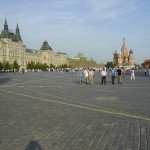 number of police manning barriers around the outside. One thing that surprised me was that Red Square is not flat, but curved, the central area being higher than the ends. Alongside and behind the magnificent St.Basil's Cathedral, at one end, there was clearly a lot of construction work in progress, and below the cathedral were some huge mounds of sand surrounded by enormous seating stands and banks of floodlights. Further investigation revealed that this was for the Red Bull International Free Style Motocross event that was being held in few days time. Now, this is hard to believe. It is equivalent to holding a motocross event in Parliament Square in London, and I cannot imagine how much money must have changed hands for it to be possible. And as for Lenin……
number of police manning barriers around the outside. One thing that surprised me was that Red Square is not flat, but curved, the central area being higher than the ends. Alongside and behind the magnificent St.Basil's Cathedral, at one end, there was clearly a lot of construction work in progress, and below the cathedral were some huge mounds of sand surrounded by enormous seating stands and banks of floodlights. Further investigation revealed that this was for the Red Bull International Free Style Motocross event that was being held in few days time. Now, this is hard to believe. It is equivalent to holding a motocross event in Parliament Square in London, and I cannot imagine how much money must have changed hands for it to be possible. And as for Lenin……
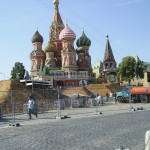 The weather was still very hot and I was consuming bottled drinks, bought from pavement vendors, at a rate almost greater than I could afford. After walking down to the bridge over the Moscow River I made my way back to the Metro and eventually the Tourist Hotel. Rosa Klebb was now in a position to organise payment for my room, and once the money was handed over she seemed much happier. It would have been interesting to find out what she thought about the St.Basil's motocross.
The weather was still very hot and I was consuming bottled drinks, bought from pavement vendors, at a rate almost greater than I could afford. After walking down to the bridge over the Moscow River I made my way back to the Metro and eventually the Tourist Hotel. Rosa Klebb was now in a position to organise payment for my room, and once the money was handed over she seemed much happier. It would have been interesting to find out what she thought about the St.Basil's motocross.
Now, most people go to Moscow to see the aforementioned sights and the Kremlin, etc., but my real aim was Lomakov's Car Museum in a suburb called Lublino. In days gone by collecting old cars would have been seen as a frivolous, capitalistic activity, and it is a sign of how much things have changed that there are now three classic car museums in Moscow, one fairly central and the other two in the suburbs.
After a thoroughly uninspiring breakfast the next morning I set off for the museums, via the Metro. Apart from anything else, I thought it would take me into areas that tourists would not normally see and I would get a better idea of the Moscow that ordinary people lived in. The first visit was to a museum called Auto-Retro, which was mainly about Russian vehicles, particularly those made in the Moscow area. On emerging from the nearby Metro station, called Ploshchad Ilycha, it was remarkably like an inner London suburb, with early 20th century buildings, shops, a small supermarket and a few kiosks selling food.
The museum surpassed all expectation, and for anyone with an interest in vehicles of the Soviet period this is the one to visit.
Next was Mr.Lomakov's museum in Lublino, an area that was very different from Ploshchad Ilycha. Around one entrance to the Metro was quite a large market, and nearby were the vast, grim blocks of flats that everyone expects to see in Russian cities. In the foreground, 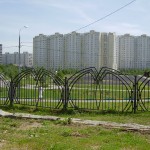 however, was a large open area with various sports facilities, and I noticed elsewhere that such buildings usually have fair-sized open spaces, often green, around them. In each building the actual condition of the flats varied greatly, some having smart double-glazed windows and others being in a totally dilapidated state.
however, was a large open area with various sports facilities, and I noticed elsewhere that such buildings usually have fair-sized open spaces, often green, around them. In each building the actual condition of the flats varied greatly, some having smart double-glazed windows and others being in a totally dilapidated state.
It was a considerable challenge to find the museum, and it turned out to be on the edge of a modern industrial/commercial area about ¼ mile away. It was a warehouse-type building, surrounded by a yard full of interesting vehicles all rusting away. The Lomakov family started collecting cars back in the Soviet days and I think the collection was kept secret for some time. An old lady took my 200r (In Russia everything seems to be 200r) and I went into the building. The contents were difficult to describe, ranging from cars and motorcycles in quite poor condition to unrecognisable lumps of rust. There was a 1937 Mercedes 540K which, even as a "barn find", would be worth a great deal of money, and a Horch in similar rough but restorable condition. Most of the vehicles were from outside the Soviet Union, which was slightly disappointing to me. When I came out I asked the old lady if I could look round the yard, but she was adamant that I could not.
I was not prepared to take no for an answer, and hung around for a couple of minutes until a man appeared in overalls. I asked him if I could look round, and he fetched another man who turned out to be Mr.Lomakov. I told him I had sent him an email from England, and with slight reluctance he agreed to take me round the yard. His English was very limited, but he had great enthusiasm for his collection as we went from rusting hulk to rusting hulk, many of which he was proposing to restore. How he was going to do that was not clear, because there were no facilities for restoration at all, and no sign of any cars that had been restored. There was a maintenance shed and a few running cars in fairly poor condition, but I got the impression that good intentions far outweighed any real achievement.
The reason for the old lady's determination not to let me wander about became apparent when we went round the back of the building and there was a large fierce dog on a long chain. For me the cars outside were more interesting than those in the museum, but sadly with the harsh Moscow winters it can only be regarded as a graveyard.
On to Autoville, in Frunzenskaya, a business and smart residential area not far from the centre of Moscow. This museum was really classy, and seemed to be aimed at the corporate entertainment market, as it was closed for a private party when I arrived. I explained that I had come all the way from England, but the man said "No, you can't come in". The theme of the collection is cars that have belonged to notable people, including Mr.Putin, but in a quick glance around I could not see any of my old cars there.
The weather was still very hot, at least 90º (32ºC), but I thought the air quality was not at all bad, certainly much better than in many large German cities under similar conditions. The reason may be that most Russian heavy industry was relocated further east as Hitler's troops approached during the war, and has remained there. Of course, I was not to know it at the time, but this was the start of a month-long period of record hot weather in Moscow, and within a couple weeks a dense smog descended on the city, partly as a result of fires in the surrounding area.
From Frunzenskaya I walked to the Moscow River, crossed over on a footbridge, and along to the next bridge through Gorky Park.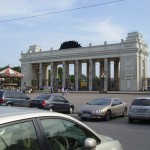 Although it was a weekday afternoon there were lots of people and children enjoying themselves, and riverside restaurants getting ready for evening visitors. It could have been anywhere in western Europe or the USA. It was a much longer walk than I had expected to the nearest Metro station, and by the time I got there I was glad to sit down on the train. Unlike London, the trains seemed to be much cooler than outside, although I don't think they are air-conditioned.
Although it was a weekday afternoon there were lots of people and children enjoying themselves, and riverside restaurants getting ready for evening visitors. It could have been anywhere in western Europe or the USA. It was a much longer walk than I had expected to the nearest Metro station, and by the time I got there I was glad to sit down on the train. Unlike London, the trains seemed to be much cooler than outside, although I don't think they are air-conditioned.
I came out of the Metro near the Kremlin Gardens, and walked from there to Lubyanka, which took me right through the city centre, leaving me with the lasting impression that there is money flowing along the streets of Moscow . What Lenin would have thought about the Bentley and Lamborghini shops within sight of the former Lubyanka Prison I cannot  imagine.
imagine.
In the course of using the Metro I had seen a number of stations with impressive decorative features, but unfortunately I did not have time to get to the famous ones with murals or sculptures designed to inspire the workers. As previously mentioned, many of the stations have two or more entrances linked by long tunnels, and these are often lined with kiosks selling everything under the sun. They are about 10ft wide by 3 or 4 ft deep, and serve their customers through a tiny hatch in the door. There are many hundreds of them in Moscow, but their proprietors must have a pretty grim existence, stuck in there for hours every day.
Back to Tver - Breakfast in the Gulag?
The next morning, after the rush hour, I set off for Tver, where I had reserved a room at the Seliger Hotel of brown water fame. The traffic was much the same as when I came, but at least I was ready for it this time, and my nerves were rather less wracked by the time I got clear of Moscow. On the way to Tver I turned off the M10 twice, once to look at a place called Gorodnya, and later on Otrokoviči. Gorodnya had bumpy roads, a pretty church and a lake, but I did not get to Ottokoviči which was on a loop road parallel to the motorway, because after some distance the road turned to loose stones all over. A couple of local cars went flying past scattering stones everywhere, so I decided that it was not worth the risk of further damage to the Skoda and turned back.
At the Seliger I drove into the car park, and the attendant, who was rather hostile on my previous visit, came down from his little hut and greeted me warmly. He said his name was Alexander, and asked me for my name. When I told him he shook my hand, so it seemed that we were now best mates, although it didn't make any difference to the parking fee.
The weather was hotter than ever, and the evening, after a further exploration of Tver, I sat in front of a café watching people going past. The majority of people looked quite fit and well, and it was very difficult to believe that the average life expectancy in Russia is 61.5 for males and 74 for females. The low figure for males is put down to accidents, poor diet, alcoholism and, in some areas, industrial pollution. I suppose brown water doesn't help.
Accidents I can understand, seeing the road conditions, but although alcoholism is supposed to be rife in Russia, I did not see any more of it than in Britain, possibly less. In the areas I went to there was certainly no shortage of good food in the shops, but it may be that many people cannot afford it. The life expectancy figures are the average for whole country, and conditions are undoubtedly very different in the industrial areas of the Urals and Siberia. According to a respected body that monitors pollution world-wide, there is one town where the average life expectancy is only 42 for men and 47 for women due to pollution from a former chemical weapons site. This figure is denied locally.
The next morning was a wonderful example of the unrelenting problems facing the independent traveller in Russia. My hotel room faced the main east-west route through Tver and I noticed a strange lack of traffic, but thought perhaps the Russians didn't do much on Saturday mornings. The plan for the day was to drive back to Novgorod, a distance of about 225 miles, and I knew that the road out of Tver to the M10 to the north was easy to find. In due course I checked out and walked round to the car park. There was no traffic apart from a bus, with no cars parked in the street, which I thought was rather strange and on the street corner near the car park entrance was a policemen standing by his Lada. I drove straight out of the car park towards the town centre, and at the next junction was stopped by a policeman, with a car marked ANR, which is the traffic police. He came round to my window and long conversation ensued in which he spoke Russian and I spoke English. It was clear that the whole town centre area was closed to traffic and he was not going to let me proceed, but I could not understand why. I showed him my map and pointed to Novgorod, and he said something which I understood to mean that he wanted to see my visa, but I when I produced it he was not interested. Eventually I realised that he was asking for a map of Tver so that he could show me the alternative route to Novgorod, but I did not have one because I was not expecting to need it.
We were clearly getting nowhere, so I indicated that I would make a U-turn and did so, which took me right into the hands of the policeman I had seen at the previous junction. Although he must have seen what had just happened he stopped me and the process began again. After a while I suggested that I should turn right, which hopefully might take me out of the restricted area. He stood back, and I went off, only to be stopped by the policeman at the next junction. By now I was wondering what the breakfasts would be like in the gulag. After yet another meaningless discussion I drove straight to the next junction, beyond which I could see traffic moving. The policeman there stared at me, and I stared back, but he apparently had the sense to see that there was no point in stopping me, as I was leaving the restricted area. I would not give much for his chances of promotion. He actually looked a bit like Stalin.
Police
The guide books all make an issue of police corruption and the practice of stopping foreigners in the street and fining them for alleged visa irregularities. There are a very large number of police around, a lot of them quite young, and they are said to be poorly paid. The only contact I had with them was the incident above, the outcome of which was quite innocuous, but I think to a considerable extent it depends upon what you look like. In a quiet area near the centre of St.Petersburg I saw a police car screech to halt in front of a perfectly decent looking young couple of oriental appearance and the officers demanded to see their documents. All the guide books say that people of Asian or Afro-Caribbean appearance can face this kind of action, and there are in fact far fewer people of obvious ethnic minorities than in most of western Europe.
The authorities are said to be sensitive about tourists photographing public buildings or military sites. When I was stopped by the police I had a video camera mounted on the dashboard which they must have seen, but they did not comment on it.
Back to St.Petersburg
The outcome of the incident in Tver was that I was hopelessly lost and finished up joining the M10 on the south side of the city, adding well over an hour to my journey. In the traffic jam on the approach to Vyšnij Voloček I turned off and went for another look round the town, which was still in a mess and no doubt will be for a long time to come.
In Novgorod I stayed in the Intourist again, and was kept awake half the night by the sound of people driving around the town with squealing tyres. For my last night in Russia I had booked a hotel called the Katharina Hof in Pushkin, quite close to St.Petersburg airport. I took the most direct route on the M10, which left me plenty of time to make a couple of diversions to look at other places along the way. The first of these was a small town called Čudovo which must have experienced a massive downpour just before I got there, because half the streets were covered with water. It was an extremely characterless town, on the main Moscow to St.Petersburg railway line, with lots of low-rise flats, an indoor market and a sort of drinking hall in the centre.
Some distance farther along the M10 I turned off on to a road number P41 which passed a village that appeared to have a main street that was not made up at all, just mud. This part of Russia is, as I expected, rather flat, and just to emphasise that in one place on the P41 there was a speed limit of 40kph (25mph) accompanied by a steep hill sign for a gradient of 3%!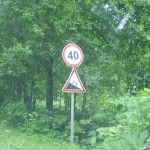
Pushkin, early on the Sunday afternoon, was a complete madhouse. It is a heavily wooded town with a number of historical buildings, the main one being the Tsar's Palace, which is quite magnificent and on a par with anything in St.Petersburg.
The Katarina Hof was, of course, extremely difficult to find, in a newly developed area on the edge of the town. It was more like a guest house than a hotel, in a residential road with nothing to show that it was anything more than a private house and I almost gave up before one of the neighbours managed to rouse someone and get the gate opened. The whole place seemed to be brand new and my initial impression was that I was the first guest that they had ever had, but there was absolutely no "can't do" attitude here, the lady in charge being really anxious to ensure that I was happy with the arrangements. When I got home I found an email from her asking me to state to arrival time of my flight and they would collect me from the airport. There were actually eight other guests, mostly German and French, and our safety was ensured by a man who seemed to live in a shed in the garden and walked around in an American-style security uniform with dark glasses, looking as if he was going to a fancy dress party.
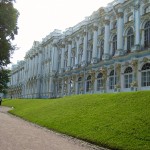 After getting sorted I went back into Pushkin, got lost in a vast park which seems to occupy most of the centre of the town, and discovered a military display with a band playing rousing music not far from the Tsar's Palace.
After getting sorted I went back into Pushkin, got lost in a vast park which seems to occupy most of the centre of the town, and discovered a military display with a band playing rousing music not far from the Tsar's Palace.
The next morning I set off for the airport and quite predictably had great difficulty in locating the Hertz base, which was in an underground car park with no signs whatsoever. It was in a big trade centre, and I could not remember where I had come out when I collected the car. The same man was there, and I showed him the crack in the windscreen, but he made no comment. However, a couple of weeks later my credit card bill came with a charge of £289 from Hertz UK for the hire and £304 from Hertz St.Petersburg for the windscreen. The trip reading on the speedometer was almost exactly 1600km (1000 miles).
It is very difficult to know what to think about Russia. There is said to be massive corruption in business and government, with increasing state control of the media, and Amnesty International says people are being tortured by the authorities. None of these things are apparent to a casual visitor, and despite the constant logistical problems I felt quite comfortable most of the time I was there. Most of the places I went to were pleasanter than I expected but it has to be remembered that I was seeing the country under very favourable weather conditions, and it might well be a different story in the winter.
The people generally seem to keep themselves to themselves in a typically north European manner, but were almost always willing to go out of their way to help when asked. Young people are very Westernised in manner and appearance, but the impression I got was that many older people have never really been able to adapt to the post-Soviet world, hence the "can't do" attitude that I came across from time to time.
On the whole trip I only encountered one Russian who was really unpleasant. I went into a building that I thought was a hotel in which I had booked a room, and just inside were three or four nice looking young ladies. I asked them if they spoke English but before they had time to reply a slightly thuggish looking man rushed in behind me and said very aggressively "What do you want?". I said I was looking for the hotel, and he said angrily "Come outside" and pointed along the road "That's the hotel, second door". It appeared that he thought I was propositioning his girls, thereby cutting out the middle man. Come to think of it, the girls actually looked a bit disappointed.
The Yotel Experience
The Yotel Experience
For my trip to Russia I needed to be at Heathrow Terminal 1 at around 5.00am. The idea of getting up at 2.30am to drive from the south coast to Heathrow was not very attractive, so I looked on the internet for hotels near the airport. Generally speaking the closer they are the more expensive they are, but there was one actually inside Terminal 4 called the Yotel that sounded interesting and would not completely break the bank.
During a trip in Japan some years ago I wanted to stay in a capsule hotel, but could not find one on my planned route. They are usually in town centres, and are aimed at businessmen who have missed the last train or cannot go home to their wives for some other reason. The accommodation provided is the bare minimum, and they really are nothing much more that a pod with a bed in it.
The idea for the Yotel came from Simon Woodroffe of Yo! Sushi fame, who wanted to make a capsule hotel that would be acceptable to westerners. He enlisted the services of the designer of the BA First Class cabins to provide a system of compact but comfortable accommodation, with three different levels, Premium, Double, and Standard. Full details can be found on www.yotel.com , and at the time of writing there are Yotels at Heathrow, Gatwick and Schiphol (Amsterdam).
Reservations and payment are made on the internet, and cabins can be booked for periods of 4 hours upwards. I booked a Standard cabin from 9.00pm to 5.00am, which suited my travel arrangements very well and would give me a reasonable night's sleep. At the time of booking you receive a reference number. At the entrance to the Yotel you enter the number and your credit card details into a computer terminal, and it gives you a receipt and room key card. Any extras that you order in the way of food and drink are then charged to your credit card.
A short distance from the entrance is a counter called the Galley, which is manned 24 hours and from which refreshments are available. It also serves as the checkout. The internal architecture of the Yotel could be described as early space modular, and there is no visible external architecture. The lighting in the corridors is indirect, in some colour between pink and purple that only a woman could put a name to.
The cabins have small windows on to the corridors, and as I walked along I was surprised to see how spacious they were. That was, until I got to mine, which was about half the size of the others. It seems that they were either Premium or Double, whereas mine was the most basic one.
It took me a while to get sorted out with my large wheelie case and small backpack. On the right hand side was a narrow 'room' containing a toilet, small washbasin and shower area. One entire wall was a mirror which effectively doubled the apparent size of the cabin. Directly in front was a fold-down table, and at the side was a folding stool like the ones used by anglers. The bed was high up on the left hand side, with a flat screen TV on the wall at one end. There seemed to be a large amount of lost space under the bed, but it appears that this actually contains the bed in the next cabin, as the cabins overlap, some having high beds and others low. The doors to the high bed cabins have a couple of steps up from the corridor and the low bed ones steps down.
The whole unit was very clean, and the only defect I could see was a small tear in the plastic covering on the side wall below the bed. To provide access to the bed there is a large fold down step, but it still requires some agility. The bed itself is 2m long by 1m wide, and seemed perfectly comfortable to me, but I am not a good person to judge, because I can sleep quite well under a polythene sheet in the corner of a field.
The air quality was ok, although there was some noise from the ventilation system. Some people might find it claustrophobic, but anyone who is used to spending time in a small yacht, camper van or submarine would have no problem. Most of the sort of people who would be likely to try it would be satisfied, but it is not for non tech-savvy arthritic octogenarians.
The TV remote control had a large QWERTY keyboard attached to it which defeated me. It was possible to select the programme channels, but I could not see how to adjust the volume, which was a bit too loud. The Yotel is said to have WiFi throughout.
To my mind the biggest advantage of the Yotel is peace of mind if you have a very early flight. You can go to sleep without having to worry about getting to the airport. However, it can take longer than you might think to get to the other terminals at Heathrow. The free Heathrow Express shuttle did not start until 5.23, and although I left the Yotel at 5.00am I did not get to Terminal 1 until about 5.45.
In front of me at the checkout was the sort of person I imagine myself to be, a tall fit-looking chap of about 25 with a large backpack, and as he handed his card in he declared himself to be well satisfied with the accommodation. No doubt he could work the TV remote.
Tecate Mexico
During my 1999 trip to California it had occurred to me that next time I could possibly go through into Mexico for a while. It would have to be on foot, because rental cars cannot be taken into Mexico. The place most people go through is Tihuana, which is a coastal tourist resort, but I heard that there were massive queues to get back into the USA, and also it is probably not very typical of Mexico. It seemed better to try somewhere more inland, and Tecate, about 40 miles from the coast came to mind.
In 2005 I was driving to Los Angeles from Monument Valley and the Grand Canyon via Lake Havasu, Yuma and San Diego, which would take me along the Mexican border. By then we had had 9/11, and entry to the USA had become more difficult, so I thought there might be complications in going through into Mexico, or at any rate, in coming back.
From my night stop in Yuma I took Interstate 8, the freeway running westwards parallel to the border, and after a few miles was surprised to see an area of Sahara type sand dunes, which are unusual in the American desert. These are the Algodones Dunes, the largest area of dunes of that type in the USA.. After about 15 miles I branched off on to highway 98, a single carriageway road much closer to the border, running through agricultural land around Mexicali and then the Yuha Desert until it rejoins the freeway. Shortly afterwards the road climbs steeply into the mountains for several miles, with telephones and supplies of radiator water every half mile, so presumably this route has a reputation for causing vehicles to break down.
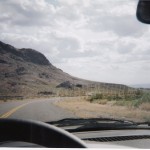 After some distance I branched off to the left again onto highway 94, which runs to within about 50 yards of the border in places. There is an ongoing problem with Mexicans trying to obtain illegal entry into the USA by crossing the desert or mountains, and a considerable number die of thirst or exposure in the process. The border just consists of a fence, and the road is heavily patrolled by Border Control officers in white 4x4s. On the Mexican side of the fence are blue flags every so often, marking the position of water containers.
After some distance I branched off to the left again onto highway 94, which runs to within about 50 yards of the border in places. There is an ongoing problem with Mexicans trying to obtain illegal entry into the USA by crossing the desert or mountains, and a considerable number die of thirst or exposure in the process. The border just consists of a fence, and the road is heavily patrolled by Border Control officers in white 4x4s. On the Mexican side of the fence are blue flags every so often, marking the position of water containers.
The mountains in this area are very barren and hostile, some appearing to be just enormous heaps of large boulders which would be almost impossible to cross. In a place called Compo I stopped at a café for a snack. It was run by two blokes named Bill and Don or something like that, and I asked them if it was possible to go through into Tecate, which was a few miles down the road. They said there should be no problem, so I took the turn off to Tecate, and the road climbed steeply with bare rocks on either side until it opened out into an area with some  warehouse-type buildings around. Ahead was a gantry over the road with a fancy sign and the word MEXICO in big brightly coloured letters. It looked more like the entrance to a fairground than a country. By now it had been raining hard for some time, and there was mud and water all around.
warehouse-type buildings around. Ahead was a gantry over the road with a fancy sign and the word MEXICO in big brightly coloured letters. It looked more like the entrance to a fairground than a country. By now it had been raining hard for some time, and there was mud and water all around.
There were three car parks, all of which looked like breakers' yards, one of them being two inches deep in mud all over. I parked the car at the side of the road where there was 20min. waiting and went to scout around. In front of the gateway to Mexico was a Border Control Officer sitting in a jeep, watching to make sure that no Mexicans came out through the 'in' gate. The 'out' gate was in a different place about 200 yards away. I asked the officer if he thought I would have any problem in going into Mexico and he said I wouldn't have as long as I had a passport.
After another look at the car parks I chose what appeared to be the best one and was relieved to find a very pleasant young lady in the Portacabin, so it seemed likely that the wheels might still be on the car when I got back.
The pedestrian entrance into Mexico was through a large turnstile, on the other side of which was a man in uniform with a machine gun. The turnstile clanged behind me and he directed me into an office. I decided to follow his orders, and went into the office, which was like something out of a film. There were two corpulent men with black moustaches sitting at desks. I held out my passport and said I would like to go into Tecate. One of them said "Why? What you want?" "I just want to see what it is like". "Why? Where you go? What you do?" "I just want to look round Tecate" "Just Tecate?" "Yes". "All right". That was it. I was in Mexico.
Tecate is an extraordinary place. If you look at Google maps you will see that the northern boundary of the town runs along the top of the mountains in a dead straight line which is the US/Mexico border, with almost nothing on the Californian side. Within a few yards you go from a bleak mountain top in California into the back streets of a Mexican town of 50,000 people, and it was very Mexican, somehow more so than I had expected.
Not surprisingly, it was a downhill walk from the border to the town centre. The street led to the main square, which had a small circular pavilion surrounded with trees. There were few people about because it was still raining fairly hard. On the way I had crossed a number of busy streets with battered cars and beaten-up buses like old American school buses, belching out black smoke, a contrast from California a few 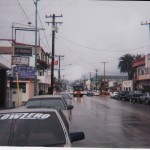 miles away. The buildings in the square were quite tidy, but elsewhere there was quite a bit of graffiti and virtually nothing of architectural note. The smartest building was the ubiquitous McDonalds, which I managed to resist and went into another café for a cup of coffee. Fortunately they were happy to accept payment in dollars, because I had no Mexican money.
miles away. The buildings in the square were quite tidy, but elsewhere there was quite a bit of graffiti and virtually nothing of architectural note. The smartest building was the ubiquitous McDonalds, which I managed to resist and went into another café for a cup of coffee. Fortunately they were happy to accept payment in dollars, because I had no Mexican money.
It was mid-afternoon on a weekday, but there were bars everywhere occupied by men with black moustaches, which are de rigueur in that part of the world. With blue eyes and no moustache I felt like a very obvious gringo, the only one in town as far as I could see, and even if I had had time to grow a moustache it wouldn't be black. At one point four policemen went past in a VW Golf, and one of them glared at  me in a manner to suggest that he would very much like to clap me behind bars if he could think of a reason.
me in a manner to suggest that he would very much like to clap me behind bars if he could think of a reason.
There were shops and business premises providing various services, but they were not the sort of places you could wander into and look around, especially with no knowledge of Spanish. In a lane off one of the main streets I found some stalls where people were sheltering under cover trying to sell cheap clothing and bric-a-brac to passers by, of which I seemed to be the only one, and I passed by.
Tecate is probably best known elsewhere as a brand of beer, and the brewery is undoubtedly the largest business in the town. The fact that there were so many men in the bars was an indication that there is a high level of unemployment, which is why Mexicans are so desperate to get into the States. The area is also noted for corruption and large-scale drug dealing, and not long after my visit four policemen were found a few miles away with their heads cut off (I didn't do it).
After a couple of hours in the rain I made my way to the US immigration office, which was in a street parallel to the one where I had come in. Totally contrary to everything I had heard, there was no queue and the two officers were sitting there with nothing to do. They examined my passport and waved me through. As I walked into the USA I had that same feeling of guilt that I got in the 1960s when returning to the West from East Berlin or Hungary - it had been so easy for me to do something that the people I was leaving behind were risking their lives to do.
Locked out in the Desert
Locked out in the desert - saved by the Germans.
It was April 1999, my second trip to California to visit my cousin in Los Angeles, and second trip to Death Valley. I 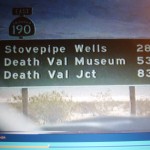 had flown to Reno in Nevada, and driven down highway 395 on the eastern side of the Sierra Nevada mountains. At Lone Pine I stopped and bought some bottled water, which you are always advised to do before going into the desert, and turned off onto highway 190 towards Death Valley. For some distance the road runs through mountains, but then drops down and levels out, into long straights stretching far into the distance, with the mountains set back several miles on either side. There was very little traffic on the road.
had flown to Reno in Nevada, and driven down highway 395 on the eastern side of the Sierra Nevada mountains. At Lone Pine I stopped and bought some bottled water, which you are always advised to do before going into the desert, and turned off onto highway 190 towards Death Valley. For some distance the road runs through mountains, but then drops down and levels out, into long straights stretching far into the distance, with the mountains set back several miles on either side. There was very little traffic on the road.
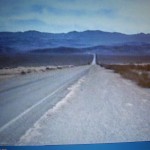 A few miles after passing Panamint Springs, which just consists of a small gas station, motel and restaurant, I wanted to make a video showing the desolation of that part of the desert, and waited until I came to a suitable spot. The road was dead straight and flat as far as the eye could see in both directions. I got out of the car with the camcorder, and panned around, satisfied that I had captured the stark isolation of the desert, and went to get back into the car. Shock, horror, the door was locked and I could see the key still in the ignition.
A few miles after passing Panamint Springs, which just consists of a small gas station, motel and restaurant, I wanted to make a video showing the desolation of that part of the desert, and waited until I came to a suitable spot. The road was dead straight and flat as far as the eye could see in both directions. I got out of the car with the camcorder, and panned around, satisfied that I had captured the stark isolation of the desert, and went to get back into the car. Shock, horror, the door was locked and I could see the key still in the ignition.
The sun was blazing out of a clear sky, and the temperature was about 85ºF (in the heart of Death Valley it was 110º). I was just wearing a T-shirt and shorts, with no hat or other protection of any sort. I picked up a rock and tried to break one of the little side windows behind the rear doors, but it absolutely refused to break. Possibly I could have broken the windscreen, but I did not want to do that at that stage,  because it was a rental car and a replacement would be expensive, apart from which I would have to drive a long way without it.
because it was a rental car and a replacement would be expensive, apart from which I would have to drive a long way without it.
After a while a car came along and stopped. It was travelling towards Death Valley, and as I was within the National Park I asked the driver to tell the rangers where I was. On my previous visit I had encountered rangers patrolling the roads from time to time, but so far this time I hadn't seen any.
After about ½ hour a people carrier came along and stopped. It turned out to be occupied by two middle-aged German couples. I explained the situation to them and they said they would go back to Panamint Springs and try to get assistance. After about 20 minutes they came back and said they had phoned through to a breakdown service in Lone Pine, and the people would be with me in about an hour. Lone Pine was 55 miles away. The Germans gave me a bottle of water and some white paper towel to put on my head, and departed. I thanked them profusely and they disappeared towards Death Valley.
As I waited it seemed to get hotter and hotter. A couple of other cars and a motorcycle stopped and I explained that help was on the way, so they went off. After I had been there about two hours I was beginning to get desperate and on 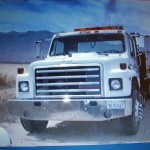 the point of breaking the windscreen when the breakdown truck arrived. It was manned by two all-American boys with baseball caps who produced a long thin strip of metal that you could buy in Wal-Mart for a few dollars, slipped it down though the door seal and in seconds the door was open.
the point of breaking the windscreen when the breakdown truck arrived. It was manned by two all-American boys with baseball caps who produced a long thin strip of metal that you could buy in Wal-Mart for a few dollars, slipped it down though the door seal and in seconds the door was open.
I asked how much I owed them, and the one in charge said he guessed it would be 100 bucks. If they hadn't been coming out to someone else as well it would have been 200. Considering the distance they had driven and the time I felt that that was actually not at all bad.
A couple of days later, as soon as I got back to civilisation I went into Wal-Mart and got a duplicate key made for the car. Unfortunately, with the modern high tech keys it is no longer possible to do that, and nowadays you just have to guard the single key with your life.
Apologies for poor photos, which were extracted from video.
London Bridge, Arizona
When my Mini broke down on London Bridge in 1962 I could not have imagined that I would be driving over the same bridge again in a small desert town in Arizona 43 years later.
When it was decided that London Bridge would be replaced by a new one in 1967 an American oil baron named Robert McCulloch expressed an interest in buying it. The story goes that he thought he would be getting the more spectacular Tower Bridge, but that has been denied by all the people actually involved.
 Mr.McCulloch had founded a city in the Arizona desert called Lake Havasu, and he thought the bridge would be a tourist attraction. In effect the site of the bridge is across the end of a lake, connected to a canal. The old bridge was not shipped lock, stock and barrel to Arizona. The Lake Havasu bridge is actually a new reinforced concrete structure, entirely clad in stone from the old one. It looks just like the old one, excepting that it is much cleaner than I remember it being in London, and probably looks more as it did when it was originally opened in 1831.
Mr.McCulloch had founded a city in the Arizona desert called Lake Havasu, and he thought the bridge would be a tourist attraction. In effect the site of the bridge is across the end of a lake, connected to a canal. The old bridge was not shipped lock, stock and barrel to Arizona. The Lake Havasu bridge is actually a new reinforced concrete structure, entirely clad in stone from the old one. It looks just like the old one, excepting that it is much cleaner than I remember it being in London, and probably looks more as it did when it was originally opened in 1831.
In the area around the bridge there are the usual British icons, a double decker bus, telephone kiosk, pillar box etc. The view through the arches of the bridge is actually very attractive, to my mind rather better than it was in London. From what I had read I was under the impression that the bridge just stood on its own in the desert, but in fact it is an important part of the road network in Lake Havasu and used by people in the course of their everyday lives. I drove over the bridge in both directions, but I could not identify the place where I broke down in 1962 because it was not possible to tell which way round the bridge was in London.
was in London.
Everything stolen – Miami 1995
It was the Saturday before the end of my Florida holiday, and I was flying home from Orlando on the Tuesday. I had booked in for two nights at the Jolly Shores Motel in North Fort Lauderdale, and decided to spend the day in Miami, taking in some places that I had not been to before.
On the Saturday morning I put a small sports bag containing things that I did not want to leave at the hotel or carry on my person into the boot of the car, and set off for Miami, a distance of about 28 miles. The car was a Nissen Sentra, with a proper boot, rather than a hatchback.
During the day I left the car parked in five or six places in Miami, mainly car parks, but a couple of times in the street. In the evening a I got back to the Jolly Shores at 9.00pm, by which time it was pitch dark, and drove to the car park at the back. I opened the boot to take out the bag, and there it was - gone! At first I could not believe it, but then looked at the panel around the boot lock, and could see that it was slightly distorted, where someone had put a screwdriver in the lock and forced it sideways. It was a very poor design, and would have taken very little time or effort to release the catch.
The bag had contained my passport, driving licence, air tickets, car hire documents, insurance documents, house keys, camera, camcorder, binoculars, shaver, and a few other bits and pieces. Fortunately I had taken my credit cards and some money with me, and there was some more money hidden inside the car. I was a bit worried about the house keys, because the person who had them also had my address, but it was unlikely that they would be able to get the keys to anyone in England before I got home. Loose in the boot had been some motorcycle parts that I had bought from Orlando Yamaha, and they were also missing.
I went into the motel and asked the manager if I could ring the police. He was reluctant at first, because motels never like being visited by the police for any reason, but he eventually agreed and I spoke to an officer, who said someone would come to the motel. Shortly afterwards a policeman arrived and I told him what had happened. He asked where the theft had taken place and I said I did not know exactly, but it was in Miami. He immediately said "If it happened in Miami you must report it in Miami". There was no way that he was going to allow a Miami crime to get into the Fort Lauderdale statistics. I rang the Miami police, and they said I should go down to the main police station in the morning.
The first thing I did on the Sunday morning was to ring the British Consulate in Orlando to arrange for a replacement passport, but I just got a recorded message saying that they were closed until Monday, but if I wanted to report a death I should ring a number in Atlanta.
Actually, I did not mind going to the police headquarters in Miami, because it was still around the time of the Miami Vice series, and I thought it might be quite interesting. When I got there I was told to wait in the entrance hall, and someone would come to see me. I had imagined that there would be a constant string of drug dealers being led through in handcuffs, and possibly a shoot-out, but all that happened was that an old lady came in and asked if she could use the toilet.
Another figment of my imagination was that I would be interviewed by a big, hard looking officer called Lewtenant Chuck Brubaker, but a young man appeared and introduced himself as Gary Green. He took me to his office, noted the details, and gave me the paperwork I needed for an insurance claim. He also came outside and looked at the car.
My flight was on the Tuesday afternoon, so I had to get back to Orlando for the Monday morning so that I could start to sort things out. It was about 250 miles to Orlando, which was not too difficult, and I booked in at a motel not far from the city centre and airport. On the Monday morning I rang the consular office and told them what had happened. The lady was very nice and said she would ring back shortly. I said I would be by the phone, as I was not going anywhere, and she said "No, you won't be, without your passport, will you". She rang back and told me I should get some passport photographs and go to the office on Tuesday morning. I had mentioned that the one thing I was not short of was money, and she sounded very relieved, because most of the people who go to that office are youngsters who have run out of money, hoping to get a sub from HM Government.
I rang Orlando Yamaha, and they said they could get replacements for the stolen parts for the Tuesday morning. The next stage was to go to the airport and get replacement air tickets, which cost about £60. Then on to Kmart for passport photos.
On the Tuesday morning I went to the consular office, which is about two thirds of the way up a sky-scraper in the city centre. It is actually the most visited British outpost in the world, but when I arrived there were no customers. The people could not have been more pleasant and helpful. They took the photos and produced a temporary passport in a very short time. It was like an A4 sheet of paper, but I had no problem with it on the journey home. On to Orlando Yamaha, who had the parts ready.
When I took the car back there was a little bit of a fuss, and they photographed the boot lock, but there were no repercussions.
As soon as I got home I made an insurance claim, and they paid for everything excepting the replacement air tickets, which were not covered.
This incident taught me a lesson about looking after my valuables when travelling abroad, and I am now very much more careful. The Foreign Office recommends that you leave things in the hotel safe, but that is not a viable proposition if you are moving on every day, and in some of the hotels I stay in it is doubtful whether anywhere is safe. Nowadays I keep my passport and other important documents with me, and if there is anything in the car boot I avoid opening it after parking in places that are at all risky.
Car museums around the world
Some of the car museums visited by Bevis on his travels. Dates are year of last visit.
BELARUS
Dudutki Folk Museum. Dudutki 2019
An ethographical museum with a small collection of mainly Soviet vehicles, including some obscure ones. http://www.dudutki.by
BELGIUM
Autoworld, Brussels 2011
Effectively the Belgian national motor museum. In government museum complex on the east side of Brussels. Most of the exhibits came from the Ghislain Mahy collection (see Mahymobiles). About 200 vehicles. Very good selection. www.autoworld.be
Mahymobiles. Leuze 2007
The main part of the collection of Ghislain Mahy, the owner of a large taxi company after the second world war. New cars were in short supply, and Mr.Mahy bought anything he could get, new or secondhand, and kept them all when they were no longer suitable for his business. Several hundred cars in this museum, and there are said to be many more in store. About 1000 including the ones in Autoworld. www.mahymobiles.be
Oldtimer Museum "Bossaert". Lo Reninge 2011
Excellent privately owned museum attached to a large general store. 95 vehicles, cars, motorcycles and military. Web site in Dutch, but understandable. www.oldtimermuseum.be
Spa-Francorchamps Racetrack Museum. 2010
A small museum attached to the Abbaye de Stavelot, with a collection of competition cars associated with the circuit and a considerable number of classic motorcycles. Also general information about the history of the circuit. www.abbayedestavelot.be
CHINA
Beijing Auto Museum, Beijing 2013
A recently opened state-run museum housed in a spectacular building vaguely reminiscent of the Mercedes Museum in Stuttgart. A fair number of Chinese and other classic cars, but largely devoted to educational displays and very popular with families. Website hard to find and only in Chinese. Just put Beijing Auto Museum into Google.
Beijing Classic Car Museum, Huairou, Beijing District. 2013
A really good museum of Chinese vehicles started many years ago by Mr. Luo Wen You, a former taxi driver. Lots of weird and interesting things, but all descriptions are in Chinese only. Mr. Luo Wen You will be pleased to see you but doesn't speak any English. http://www.laoyeche.org (Chinese).
CUBA
Museo del Autovil, Havana. 2011
The streets of Havana are full of classic vehicles, almost all post 1945, but this small museum has a number of older American cars and a 'barn-find' 1920s Rolls-Royce open tourer. Also some fairly obscure cars and motorcycles of the 1960s and 70s, including MG and Maserati replicas.
CYPRUS
Cyprus Classic Motorcycle Museum, Nicosia 2019
This museum is owned by Andreas Nicolaou, a proper biker, who has a large collection of classic vehicles. About 100 motorcycles are in the museum, many of them British. A really good place for oily rag enthusiasts. http://agrino.org/motormuseum
Cyprus Historic and Classic Motor Museum, Limassol 2019
Founded by Dimi Mavropoulos, a local rally-driving legend, this museum has over 150 exhibits, including a few commercial vehicles and automobilia, all well displayed. Highly recommended. www.cyprusmotormuseum.com.cy
Near East University Classic Car Museum, North Nicosia 2019
A very smart museum on the NEU campus about 5 km north of Nicosia, the collection is divided into two sections: modern sports cars, including supercars, and traditional classic cars plus some motorcycles. Many of these vehicles are British. A good collection, clean and well-displayed but the entry fee is a bit over the top at 20 euros. www.cypruscarmuseum.com
CZECH REPUBLIC
Skoda Auto Museum 2010
An excellent museum attached to the Skoda factory at Mlada Boleslav about 35 miles from Prague. Skoda is one of the oldest car manufacturers in the world, and the museum covers the whole of the 20th century including the Soviet period. http://new.skoda-auto.com
ESTONIA
Automuseum Halingal . E67 Loomse 2019
A recently built museum with a good display of about 50 mainly iron-curtain cars, some unusual. The whole place is immaculate, including most of the cars. Car descriptions in English. http://www.automuuseum.ee
Jarva-Janni Classic Car Park. Jarva-Jaani 2019
A wonderful open-air collection of East European vehicles, originally fire-engines but now including cars, lorries, buses, motorcycles, and many other strange machines. There is no cash desk, you put the entry charge in a box under the bonnet of an ancient Zaporozhets. An indoor museum is now being built with EU support, but hopefully most of the outdoor exhibits will remain. Unmissable. http://www.varjupaik.jjts.ee
FRANCE
Cité de l'Automobile - Musée National - Collection Schlumpf Mulhouse 2008
Originally a collection of over 120 Bugattis built up in secret by the Schumpf brothers who owned a textile business, many more cars were added and it is now the French national motor museum. A vast collection, beautifully displayed, and without a doubt one of the best motor museums in the world. www.collection-schlumpf.com
Musée Automobile Reims Champagne. Reims 1994
An excellent collection with many important one-off designs, mainly French. Cars, lorries and motorcycles. www.musee-automobile-reims-champagne.com
Conservatoire National des Arts et Métiers. Paris 2005
The French equivalent of our Science Museum. A few vehicles, but by far the most interesting is Cugnot's Steam Wagon of 1769, claimed to be the world's first motor vehicle. www.arts-et-metiers.net
There are very many more unvisited museums in France.
FINLAND
Espoo Car Museum, Espoo near Helsinki 2019
An exceptionally good museum, run by enthusiasts for enthusiasts. A vast collection of cars and motorcycles, including microcars, mopeds and scooters from both sides of the iron curtain. Highly recommended. Descriptions mostly in Finnish, but website in English. www.espoonautomuseo.com
Helsinki Car Museum. Helsinki 2008
A small museum, about 20 vehicles, but a collection of 5000 models of Mercedes Benz vehicles of all sorts. www.automuseo.fi (in Finnish) This museum may now have closed.
Lahti Motorcycle Museum. Lahti 2019
An excellent museum, owned by a Finnish man who has close connections to Britain and the Ace Cafe in London. Many interesting bikes in a widely varying state of preservation and a London bus for bringing people from Lahti in the summer. Definitely worth a visit. www.moottoripyoramuseo.fi
Mobilia Museum. Kangasala 2019
An extremely smart museum in which you could eat off the floor. A moderate number of exhibits but well-displayed with a large rally car section. Family orientated and educational. Also has time-limited themed displays and trade shows. www.mobilia.fi
Uudenkaupungin Car Museum. Uusikaupunki 2019
Adjacent to the Valmet car development and assembly plant, this museum is divided into 3 sections: a good general display of cars and motorcycles, a SAAB hall, and other vehicles made by Valmet. The SAAB hall has about 40 cars, ranging from the 92 to the final GM based models. Obscurely situated but worth visiting. www.visituusikaupunki.fi/fi/automuseo
Vehoniemen Car Museum. Kangasala 2019
A good selection of cars and motorcycles with a shop selling models and a cafe. Rather strangely they have an immaculate engine from a British Trojan car. www.automuseo.com
GERMAN
Audi Museummobile. Ingolstadt 2009
A large museum, attached to the Audi factory. Covers all makes historically associated with Audi, e.g. Auto Union, DKW, Wanderer, Horch, NSU. Cars and motorcycles. Very well displayed. www.audi.de/foren
Auto & Technik Museum Sinsheim. Sinsheim 2010
Considered by many people to be the best technical museum in the world, there are 300 cars, 200 motorcycles, and many aircraft including Concord and Tupolev 144. Also military and marine exhibits. Fantastic. www.technik-museum.de
Automobile-Museum Dortmund. Dortmund 2012
About 80 vehicles, cars and motorcycles, with a slight emphasis on Jaguars. Well displayed www.oldiemuseum.de
Automuseum Melle. Melle 2012
A large and varied collection, cars and motorcycles, well displayed. www.automuseummelle.de
Automuseum Rosso Bianco. Aschaffenburg. 2003
A wonderful collection of 200 sports cars, many of exceptional interest. Sadly now closed. Some cars were sold privately, but others went to the Louwman Collection in Holland see below)
Autovision. Mannheim 2010
A private museum with the theme of alternative power, particularly electricity and Wankel engines. Very high technical interest. Collection of cars, motorcycles, engines, and NSU section. www.autovision-tradition.de
BMW Museum am Olympiaturm. Munich 2007
This was a temporary display in an inflatable building, with selected cars and motorcycles from the original museum, which was being rebuilt. Now closed.
BMW Museum. Munich 2009
A new museum, adjoining the BMW factory. Car and motorcycles and some aviation. In some respects disappointing, with a complicated layout and little natural lighting. www.bmw-museum.com
Classic Remise. Dusseldorf 2012, 2014
Strictly speaking this is not a museum, but a classic car centre incorporating a small museum section. Formerly known as Meilenwerk it comprises storage facilities for classic vehicles with shops selling vehicles, clothing and accessories, a large car sales area and cafe all under one roof in a former locomotive building. Altogether there are about 200 vehicles, including many exotic ones, and entry is free during normal working hours. An unmissable experience for classic vehicle enthusiasts. www.remise.de
Classic Remise. Berlin 2012
This is a sister classic car centre to the Dusseldorf one above, but may be slightly smaller, with more workshops and fewer sales outlets. Still a very good selection of cars and well worth visiting. www.remise.de
Deutsches Museum Verkehrszentrum. Munich 2009
This is the transport section of the Deutsches Museum, a technical museum similar to our Science Museum. Cars, motorcycles, lorries, trains, bicycles. Has the only original 1885 Benz Patent Motorwagen in existence (though it may have been built later than 1885). Also an Auto-Union Silver Arrow. Superb collection. www.deutsches-museum.de
Deutsches Technikmuseum Mensch in Fahrt. Berlin 2012
A permanent display of vehicles, including about 30 cars, associated with the adjacent German Technical Museum. Relatively small, but quite good. www.sdtb.de
Deutsches Zweirad-Museum and NSU Museum. Neckarsulm 2010
The German national motorcycle museum. On several floors in a quaint old building in the centre of Neckarsulm, the home town of NSU. Separate section devoted to NSU products. Excellent. www.zweirad-museum.de
Eisenach Automobile Welt. Eisenach 1994
This is the museum of the former Wartburg factory, which was owned by BMW before the war and has many exhibits dating from that period. At the time of visit it was in a separate building, but has since been moved to the site of the former factory. Worth visiting. www.ame.eisenachonline.de
1. Berliner DDR Motorrad-Museum. Berlin 2012
A marvellous collection of over 140 motorcycles made in East Germany (DDR) during the Communist post-war period. Mostly well-restored and well-displayed. Mainly MZ and Simson, but a number of other little-known makes. www.erstesberliner-ddr-motorradmuseum.de
Hockenheimring Motor Sport Museum. Hockenheim 2010
Some racing and motor sport orientated cars on the ground floor, but this museum is now mainly dedicated to motorcycles. In the gallery are many British classic machines, loaned or donated to the museum by a German collector. Website is confusing and museum information is only in German. www.hockenheimring.net
Mercedes-Benz Museum. Stuttgart 2008
A huge display of Mercedes vehicles in an ultra-modern building, opened in 2008. Very popular, and can have long waiting times at peak periods, such as Saturday morning. Adjoining factory complex, with showroom, restaurant etc. www.mercedes-benz.com/museum
Motorradmuseum Ibbenbeuren. Ibbenbeuren 2008
An excellent private motorcycle museum. www.ibbenbeuren.de
Porsche Museum. Stuttgart 2010
An excellent museum in an impressive new building adjacent to the Porsche factory, opened in 2009. A large number of cars very well displayed. www.porsche.com
Rosengart-Museum, Beburg-Rath, nr. Cologne. 2011
A small but excellent museum dedicated to the life and work of Lucien Rosengart, a Frenchman who made Rosengart cars from the 1920s until 1953. About 30 cars are displayed, including many licence-built versions of the Austin 7 and some larger front wheel drive models based to some extent on Audi and Citroen engineering. The museum is a popular meeting place for classic car enthusiasts and has an large outdoor restaurant. www.rosengart-museum.de
Technik Museum Speyer. Speyer 1996
Difficult though it is to believe, but this museum is an extension of the one at Sinsheim. 50 cars, plus aircraft and marine items, including a U-boat and a Russian space shuttle. www.technik-museum.de
Unimog Museum. Rastatt. 2008
Although Unimog is a Mercedes product, it has this small independently-run museum of its own with an adjacent test track, on which you can be taken for a demonstration run over obstacles. www.unimog-museum.de
There are very many more car museums in Germany. See www.deutsche-museumsstrasse.de
HOLLAND
Autotron. 's Hertogenbosch 2003
This was a large and very good museum, sadly now closed. Many of the exhibits went to the Louwman Collection.
Louwman Collection. Raamdonksveer 2003
A fantastic collection, now the Dutch National Motor Museum. It was built up by the Louwman family, who imported cars into Holland, and has many outstanding and rare exhibits. It closed in 2009, pending a move to the Hague (see below)
DAF Museum. Eindhoven 2012
About 40 trucks and a similar number of cars are displayed in this old building, which was the original home of the Van Doorne company. There are many prototypes and competition vehicles, with an emphasis on the Variomatic belt drive transmission for cars, which was the company's speciality. www.daf-museum.nl
Louwman Collection. Den Haag (The Hague) 2011
A world class museum, in impressive new purpose-built premises. Many rare or unique cars, extremely well displayed, together with an automotive art gallery. www.louwmanmuseum.nl
ICELAND
Skogar Transportation Museum, Skogar 2013
Associated with the excellent Skogar Folk Museum, this is a display of vehicles and communication equipment used in Iceland in the 19th and 20th centuries, including about 15 vehicles. These are mostly special-purpose tracked or 4x4 vehicles, including a Citroen Kegresse half-track used for crossing the interior in the 1920s. www.skogasafn.is/en/museum-of-transport
ITALY
Museo Alfa Romeo. Milan 2016
Based at the Alfa Romeo headquarters, this museum is as prestigious as might be expected, although a little cramped in some parts. Includes a documentation centre, bookshop, showroom, virtual reality area, and perhaps best avoided, a 4-D cinema. http://www.museoalfaromeo.com
Museo Enzo Ferrari. Modena 2016
On the site of Enzo Ferrari's house in the centre of Modena, this museum actually has little about the man himself, but does have an excellent display of engines and cars, in some ways better laid out than the factory museum, with which it is associated. http://www.museomodena.ferrari.com
Museo Ferrari. Maranello 2016
The main Ferrari factory museum, it is very popular with the public and can be a bit crowded. Examples of most Ferrari road and racing cars and engines. http://www.museomaranello.ferrari.com
Museo Lamborghini. Sant'Agata 2016
Attached to the main Lamborghini office block, this museum has examples of every model produced by the company. Expensive, considering its size, but Lamborghini is Lamborghini. http://www.lamborghini.com
Museo Mille Miglia. Brescia 2016
A really excellent museum, housed in a former monastery, displaying cars, customs and curiosities (their description) from the Mille Miglia races between 1927 ando 1957. Includes many 'etceterini' low-volume sports cars from the 1940s and 50s. http://www.museomillemiglia.it
Museo Nazionale dell'Automobile di Torino. Turin 2016
The Italian Nation Automobile Museum has a about 200 cars from around the world, but as might be expected, with an emphasis on Italian makes. Well-displayed apart from rather poor lighting. http://www.museoauto.it
Museo Tazio Nuvolari. Mantova 2016
Not strictly speaking a car museum, but dedicated to Tazio Nuvolari (1892 - 1953), one of the world's most famous racing drivers. Run by enthusiasts and very atmospheric, it is housed in an old building in the back streets of Mantova. http://www.tazionuvolari.it
JAPAN
Motor Car Museum of Japan. Komatsu 2007, 2015
Housed in a British-style red brick building, this huge collection was built up by the man who introduced that building method to Japan in the 1970s and made a fortune. After delivering the bricks he collected dumped cars from his customers and put them in a field, until there were so many that he decided to start a museum. 500 cars and motorcycles. Brilliant. Also a collection of urinals from around the world. This could only be Japan. http://www.mmj-car.com
Prince & Skyline Museum, Okaya 2015
In a smart modern building perched on the top of a hill in a park, this museum is strictly for fans of the long-defunct Prince marque, and its successors, the Datsun/Nissan high-performance Skyline models. Not worth the time and high entry cost unless you are a total anorak for these cars. Website totally Japanese.
Toyota Automobile Museum. Nagoya 2007, 2015
A very large and varied collection of cars from all over the world, beautifully displayed, with no pro-Toyota bias. Examples of the licence-built Austin, Hillman, and Renault cars of the 1950s. www.toyota.co.jp/Museum
LATVIA
Riga Motor Museum. Riga 2006
Cars and motorcycles, with an Iron Curtain bias. The prize exhibit is an Auto Union Silver Arrow that was rescued from being broken up in Russia, although the one on display may be a C & G replica. www.motormuzejs.lv
PORTUGAL
Automobile Museum, Vila Nova de Familicao. 2017
An excellent museum, mainly intended for educational purposes, with a some unusual microcars and other rare models, mostly European. Also motorcycles. museoautomovelfamalicao@gmail.com
Caramulo Museum, Caramulo 2017
Situated in a remote area about 70 miles from Porto this museum has some exotic cars including Ferraris, Bugattis and a Pegaso. All well displayed and worth the effort to get there. http://www.museo-caramulo.net
Museum of Transport and Communications. Porto 2017
The car section of this museum is dedicated entirely to vehicles used by dictators and presidents of Portugal. It makes a point of demonstrating the move away from top-of-the-range Rolls-Royce and Mercedes to BMW and Audi as the country has become more democratic. Only about 15 cars, but easy to get to. http://www.amtc.pt (Portugese)
RUSSIA
Autoville. Moscow 2010
When visited this museum was acually closed for a private party, and appears to be aimed at the corporate hospitality business. Very smart, about 30 cars, mainly formerly owned by notable people, including Mr.Putin. Website in Russian. www.autoville.ru
Lomakov Museum of Antique Cars and Motorcycles. Moscow 2010
The Lomakov family started collecting cars in 1964 and this is a sizeable collection, with a large proportion of non-Russian manufacture. Some interesting vehicles, but many in poor condition. Many interesting cars outside, but these are not normally accessible to visitors. www.lomakovka.ru
Retro-Auto Museum. Moscow 2010
This is the one to visit if you are interested in vehicles of the Soviet era. Most of the former Moskvitch museum is here, including many prototypes. Commercial vehicles as well. Excellent. www.auto-retro-museum.ru
There are also some cars in the Polytechnic museum in central Moscow.
SLOVENIA
Technical Museum. Ljubljana 2005
This museum has two fairly large vehicle sections, one for cars and motorcycles, with a local bias, and the other for the cars of Marshall Tito. These are more varied than might be expected, because most of them were given to him by governments trying to influence him. www.tms.si
SOUTH KOREA
Samsung Transportation Museum. Jongin 2013
A good collection of classic cars from around the world, with a rather strange outdoor display of American car shells entirely painted silver for artistic effect. Some early Korean cars (1970s and 80s) and a real oddity, one of the Docker Daimler show cars from the 1950s. No Samsung cars, although they are still in production, now made in Korea by Renault. Also trains and aircraft. www.stm.or.kr/english/index.html
THAILAND
Jesada Technik Museum, Nakhon Phathom 73120 2018
An astonishing collection of vehicles, mainly cars and motorcycles from Europe. Many rare and unusual types including microcars. Racks of pedal cars and a large reserve collection of motorcycles. It is a private museum and entry is free. In the countryside about 25 miles west of Bangkok. http://www.jesadatechikmuseum.com
TURKEY
Mehmet Arsay Classic Car Museum. Istanbul 2016
A collection of about 80 cars from around the world, many American and all in superb condition. A lot of iconic models from the 1920s and 30s. Beautifully displayed in a warehouse on an industrial estate, and believed to be the property of one man. The curator was very pleasant and enthusiastic, but did not speak English. Free entry. http://www.klasikotomobilmuzesi.org (in Turkish)
Rahmi M Koc Museum. Istanbul 2016
A good collection of cars in an excellent museum covering all forms of transport. A number of Anadol and other Turkish cars not found elsewhere. Also rally cars, boats, trains and aircraft. http://www.rmk-museum.org.tr
Ural Ataman Classic Car Museum. Istanbul 2016
Another excellent privately-owned museum containing many high value cars, all in perfect condition. Presented in the style of a classic American diner, with petrol pumps and dozens of working neon signs. Obscured situated in the back streets of a northern suberb of Istanbul. Everything perfect. http://www.atamanmuseum.com
USA
Auburn Cord Duesenberg Museum. Auburn, Indiana 2014
A high-quality museum in the former headquarters of the manufacturer. An excellent display of superb cars, much larger than might be expected bearing in mind the relatively small size of the company. Highly recommended. http://www.automobilemuseum.org
Auto Collections at LINQ Casino. Las Vegas, Nevada 2017
Formerly the Imperial Palace Auto Collection, this is now an upmarket dealership, and most of the outstanding exhibits have been replaced by cars with more public appeal but less technical interest. http://www.autocollections.com
Autoklassix Corvette Museum. Daytona, Florida 1995
Strictly for Corvette cognoscenti. An example of every model for every year of production. Finished and became Klassix (see below).
Automobile Driving Museum. El Segundo, California 2017
A good private collection of about 130 mainly American cars, well-presented and run by friendly people. http://www.automobiledrivingmuseum.com
Bellms Cars and Music. Sarasota, Florida 1997
When first visited in 1989 this museum had a superb collection of cars and antique musical instruments. It declined over the years and eventually, in reduced form, without the music, became Sarasota Classic Car Museum (see below).
Blackhawk Automotive Museum. Danville, California 2008, 2017
At the time of the 2008 visit this was a fabulous museum with the 3 Alfa Romeo BAT cars, one of the only two Buchiali TAV12s, a Pierce Arrow Silver Arrow and Bugatti Royale. By 2017 the BAT cars were still there but many of the best ones had gone. Still worth visiting. Display spoilt by poor lighting (spot lights). www.blackhawkmuseum.org
Collier Collection. Naples, Florida 1992
A fabulous private collection, mainly sports and racing cars, in an industrial building on the outskirts of Naples. No longer open to the public, but occasionally to invited groups. The owner, Miles Collier, is still adding to the collection from time to time.
Doc's Classic Car & Cycle Museum. Bonduel, Wisconsin 2014
A collection of vehicles and automobilia attached to a large Harley Davidson dealership. Some really oddball things, especially motorcycles. http://www.docshd.com
Don Garlitt's Ford Museum. Ocala, Florida 1998
At the time of visit there were two museums on this site, one for dragsters and the other for Fords. The Ford museum was quite large but very American and probably of limited interest to many people. It now appears to have been enlarged and become a general classic car museum, though still predominantly American. www.garlits.com
Elliott Museum. Stuart, Florida 1993
Sterling Elliott was an inventor and this museum in his house is dedicated to his memory. There are about 10 cars, ranging from 1903 to 1954. Stanley Steamer, Bugatti and Briggs. Also, at the time of visit, a Morris Minor. Museum has moved into new premises since visited. www.elliottmuseumfl.org
Elvis Presley's Automobile Museum, Memphis, Tennessee 2011
Part of the Graceland complex, this museum has about 33 vehicles owned by Elvis Presley, including exotic cars, motorcycles, a tractor and a snowmobile modified for driving on the Graceland lawns. Rolls-Royces, Cadillacs, a Ferrari, Stutz Blackhawk, Harleys, everything you might have expected Elvis to own. Elvis.com
Harley-Davidson Museum. Milwaukee, Wisconsin 2014
The company's official museum, adjacent to the factory. Examples of every model ever made, with displays of engines, fuel tanks and lots of information about the history of H-D. The whole set-up has an appropriate heavy metal style. http://www.h-dmuseumcom
Harrah's Automobile Collection. Reno, Nevada 1983
In 1983 there is little doubt that this was the best car museum in the world. 1200 cars, many awaiting restoration in open sheds outside. 2 Bugatti Royales (out of 6 made) and a lot of other unique or very rare cars like the Dymaxion and the Stout Scarab. Built up by William Harrah of Harrah's Casino, and when he died a large proportion of the exhibits were sold, a core of about two hundred becoming the National Automobile Museum (see below). Many of the best cars went to what is now the Blackhawk Museum and the Imperial Palace Museum in Las Vegas. (see below).
Henn's T-Bird Swap Shop Museum. Fort Lauderdale, Florida 2010, 2018
A collection about 12 very high performance cars, mainly Ferraris and mostly with a top speed of over 200mph. Recent addition is a Bugatti Veyron. Displayed at Henn's T-Bird Swap Shop, a vast market and drive-in cinema complex. By 2018 the collection had been expanded to about 30 cars. Website has video tour. www.floridaswapshop.com
The Henry Ford Museum. Dearborn, Michigan 2014
Considered to be one of the best car museums, it also covers other forms of transport and many aspects of life in the 20th century. Has one of the six Type 41 Bugatti Royales and the car in which President Kennedy was assassinated. http://www.TheHenryFord.org
Imperial Palace Auto Collections. Las Vegas, Nevada 2008
Perhaps not quite as exotic as Blackhawk, but not far short and the cars are better displayed. Many coachbuilt Rolls-Royces and other luxury cars of the 1920s, 30s and 40s. Most are for sale but don't expect to get anything for less than $200,000. Now renamed the Auto Collections at LINQ Casino. (see above)
Klassix. Daytona, Florida 2003
In the same building as Autoklassix, but a more general collection with motorcycles and a lot of automobilia. Vastly overpriced. Closed 2003.
Lane Motor Museum. Nashville, Tennessee 2011
An excellent privately owned collection of rare and interesting vehicles, many from Europe. A considerable number of unique prototype cars, plus microcars, motorcycles, military vehicles and a display of Tatras. A friendly museum, in which photography is welcomed. Very well worth visiting. www.LaneMuseum.org
Larz Anderson Museum. Boston, Massachusetts 2006
A unique museum. Larz Anderson was a wealthy man with an estate in Boston at the start of the 20th century. He bought cars, mostly expensive ones, used them for a couple of years, and then put them in his outbuildings. Eventually he had a new Motor House built in the style of a French chateau, and that is where they are today, still exactly as when he last used them. He had 14 cars, but some others were added later. www.larzanderson.org
Marconi Automotive Museum. Tustin, California 2016
A good collection of mainly high-performance cars and motorcycles, owned by Dick Marconi. Some rare and exotic machines. Entry charge is a donation to a children's charity. http://www.marconimuseum.org
Museum of Alaska Transportation and Industry. Wasilla, Alaska 2012
A museum covering all aspects of transportation, with a number of cars, including some equipped to travel along railroad tracks for maintenance purposes. Most of the exhibits are exposed to the elements and deteriorating, which seems to be common practice in Alaskan museums. www.museumofalaska.org
National Automobile Museum. Reno, Nevada 1999
About 220 cars from the original Harrah collection, well displayed. The Dymaxion is still there, and there are many good cars, but for exotica it cannot match Blackhawk or the Imperial Palace. www.automuseum.org
National Automotive & Truck Museum. Auburn, Indiana 2014
A really good collection of cars and commercial vehicles adjacent to the Auburn Cord Duesenberg Museum. Run by enthusiastic friendly people. http://www.natmus.org
Petersen Automotive Museum. Los Angeles, California 2005, 2017
Another high-class museum, with many rare and unusual cars. Has temporary exhibitions lasting a few months with different themes. High standard maintained in 2017. www.petersen.org
San Diego Automotive Museum. San Diego, California 2005
A large collection of cars, motorcycles and automobilia with a considerable European content. www.sdautomuseum.info
Sarasota Classic Car Museum. Sarasota, Florida 2004
A slimmed down descendent of Bellms Cars and Music, with about 100 cars. Average interest, although at the time of the last visit there was an Invicta Black Prince Convertible, which seemed rather improbable and no one could explain how it got there. www.sarasotacarmuseum.org
Shelby Museum. Las Vegas, Nevada 2008
A small museum (enlarged since 2008) attached to the Shelby factory where Shelby Cobras are still built, as well the Shelby Mustangs. As might be expected, most of the cars are Cobras and Mustangs in one form or another. Free factory tour on weekday mornings. www.carollshelby.com There is an unconnected Shelby American Museum at Boulder, not far away.
Snook's Dream Cars. Bowling Green, Ohio 2014
An excellent private collection of vehicles and automobilia in buildings fronted by a classical 1950s-style service station and workshop. http://www.snooksdreamcars.com
Volo Auto Museum. Volo, Illinois 2014
This is mainly a classic car dealership with five enormous showrooms containing hundreds of cars, mostly in outstanding condition. Most of the cars are for sale, but some permanent exhibits are connected with famous people such as James Dean, Marilyn Monroe and James Bond. Also a military section. The business seems to be run by dedicated people and the prices are reasonable by European standards. Worth a visit if you are looking for an American classic car. http://www.volocars.com
There are very many more museums in the USA.
UNITED ARAB EMIRATES
Emirates National Auto Museum. Abu Dhabi 2015
A private collection of about 200 vehicles, the property of Sheikh Hamid Bin Hamdan Al Nahyan. Housed in a pyramid-like building in the desert, it covers a wide range of cars and commercial vehicles, with special emphasis on ones suitable for the local conditions. The centerpiece is a huge 1980s-style American pick-up with several normal pick-ups parked underneath it. http://www.enam.ae
Sharjah Classic Cars Museum. Sharjah 2015
A state-run museum operated in conjunction with the Sharjah Old Car Club. About 100 cars and motorcycles from around the world, covering most of the 20th century. http://www.sharjahmuseums.ae
For over 1100 car museums world wide see http://www.automuseums.info
Slovenia and Croatia 2005
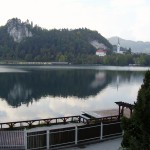 The reason for my visit to Slovenia was probably fairly unusual - it was to attend a Japanese conference. The Japanese company with which I have been involved for many years has a European agents conference every two years, hosted by one of the agents, and at a previous meeting someone asked where the next one would be held. "Slovenia", we were told. This met with blank faces. No one, including me, had any idea where it was.
The reason for my visit to Slovenia was probably fairly unusual - it was to attend a Japanese conference. The Japanese company with which I have been involved for many years has a European agents conference every two years, hosted by one of the agents, and at a previous meeting someone asked where the next one would be held. "Slovenia", we were told. This met with blank faces. No one, including me, had any idea where it was.
In fact, it is the northernmost state of the former Yugoslavia, situated between Austria, Italy, Croatia and Hungary. It became independent in 1991, after a very brief struggle, and while some of the other parts of the former Yugoslavia devoted their energy to things like ethnic cleansing, the Slovenians concentrated on building up a decent economy. They had an advantage in that the area was already more industrialised than the states to the south.
The conference was held in Maribor only on a Friday, so I decided to fly out on the Thursday and return on Sunday, which would give me a chance to have a look round. Maribor is a mountain and ski resort in the north east of the country, quite close to the Austrian border.
The only international airport is at Ljubljana, the capital, and I flew from Gatwick with Adria Airways, a small Slovenia airline, arriving at 12.45. After picking up a Citroen C3 Diesel from National Car Rental I set off for Bled, in the north west of the country. Bled is a noted tourist resort, with a lake, mountains and a castle.
My first stop was a town a few miles from the airport called Kranj (pronounced something like Kran-ya) the main feature of which was at first sight a massive communist era factory making resistors, but the town centre was actually quite picturesque. From there, as I had plenty of time I took a real country route to Bled, via a place called Kropa. After quite a long distance there were cones and signs indicating that the road was closed. I had met several big lorries carrying aggregates, so I thought it must be possible to get through, and it was a very long way to go back, so I decided to carry on. It did go through, but when I told some local people about it the next day they said "Didn't you see the red flags? When the road is closed it means that they are blasting at the quarry". Oh, well.
In Bled I found a guest house quite quickly, and went for a look round. It was really beautiful, quite like Switzerland. On the lake there were superbly varnished wooden launches, with big paddles at the stern, and they are rowed along 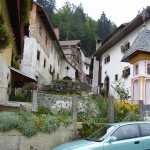 by old men who are themselves a feature of the place, but, not surprisingly, it is proving to be difficult to find youngsters to take on the task. There were plenty of restaurants still open in the evening in September.
by old men who are themselves a feature of the place, but, not surprisingly, it is proving to be difficult to find youngsters to take on the task. There were plenty of restaurants still open in the evening in September.
The next morning it was pouring with rain and I set off for Maribor, The country has a good network of motorways, but there is a toll, and I am too mean to pay. Also, the free map I had from the tourist office said 'Byways are more attractive than Highways'. The only practical route was to go back to the airport (avoiding the closed road) and then take a cross-country route via a town called Velenje. At one point I branched off on to a long cul-de-sac road to a ski and sports resort in the mountains called Kamnisca Bistrica, but when I got there it turned out to be a privately run venture, and was closed. Anyway, the scenery was good.
It just rained and rained, and I was equipped for a conference, not for wandering about in those conditions, so all I could do was to keep driving. The road ran between mountains of up to 1500m all the way, so it was picturesque, if a bit depressing. Some time after stopping for a snack I came to a place called Oplotnica, and the map, which was about 6 miles to the inch, showed a mountain road from there to Maribor. The route proved to be far more complicated on the ground than it appeared on the map, and not long after entering a forest the road began to deteriorate. It started to go downhill, literally, and turned into a muddy track, with bits of wood all over it. I had serious doubts about whether I could get back up the hill, so I decided to keep my nerve and carry on. The hill got steeper, but eventually, to my immense relief, the road got better and came into a village. This was certainly not the road shown on the map, but it did lead to Maribor and the conference centre.
The conference the next day was what such conferences always are, people whose English is not very good trying to communicate technical material to other people whose English is not very good.
 In the evening we were taken by coach into Maribor for a meal. The coach was left in the centre and we walked (about 40 people) half a mile through a park to the restaurant. When we came out at 10.00pm we walked back through the park. In this situation protocol dictates that the Japanese principals must walk in front, which was not ideal, because they were about 5ft5in tall, and in the park were around 200 youngsters in groups of about 5 or 10 with bottles. Fortunately, we had some big German and Scandinavian men in our group who were the sort of people you wouldn't mess with, so the youngsters responded only with loud comments that we couldn't understand.
In the evening we were taken by coach into Maribor for a meal. The coach was left in the centre and we walked (about 40 people) half a mile through a park to the restaurant. When we came out at 10.00pm we walked back through the park. In this situation protocol dictates that the Japanese principals must walk in front, which was not ideal, because they were about 5ft5in tall, and in the park were around 200 youngsters in groups of about 5 or 10 with bottles. Fortunately, we had some big German and Scandinavian men in our group who were the sort of people you wouldn't mess with, so the youngsters responded only with loud comments that we couldn't understand.
The conference centre was a sports hotel at the foot of a mountain with a gondala to the summit, and they had 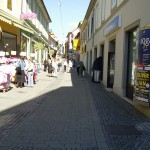 mountain bikes that were free for guests to use. Over the meal a Swede named Roger said he would quite like to ride down the mountain the next morning, so I said I would join him. By morning it had stopped raining at last, and as we were getting ready after breakfast a Swiss bloke named Mario decided to come with us. Out of about 15 bikes there were only two decent ones, one large and one small, which Roger and I had already got, so Mario finished up with one with no back brake, but he said it didn't matter because he had been riding down mountains in Switzerland since he was 10.
mountain bikes that were free for guests to use. Over the meal a Swede named Roger said he would quite like to ride down the mountain the next morning, so I said I would join him. By morning it had stopped raining at last, and as we were getting ready after breakfast a Swiss bloke named Mario decided to come with us. Out of about 15 bikes there were only two decent ones, one large and one small, which Roger and I had already got, so Mario finished up with one with no back brake, but he said it didn't matter because he had been riding down mountains in Switzerland since he was 10.
The chairman of the Japanese company was very worried, because he thought he was on the point of losing three agents, but we brushed his concerns aside and went up the mountain. I must admit that on the way down I couldn't keep up with the other two, who were at least 20 years younger than me, but we survived.
After the bike ride I went into Maribor for a look round. It is the second largest city in Slovenia, and the central area is clean and tidy with many well preserved old buildings. There was a market with stalls offering all kinds of food, and a lady persuaded me to buy a piece of thick bread with a slab of white stuff on it. I asked her what it was, and she said "Fett". Several other people joined in and said "Fett", which I knew to be German for lard in that context. Not the sort of thing to eat too much of, but having bought it I had to eat it.
I then set off for Croatia, which was only about 30 miles. At the border there was a queue of lorries because it is an EU frontier, but I drove slowly past them on the wrong side of the road, and showed my papers to the person at the check point. On the Croatian side there was a massive amount of civil engineering work, mainly road-building. Shortly after the frontier I turned off into the mountains, and as the road climbed I looked down on to a village or small town below. It was amazingly different from anything I had seen in Slovenia, with Soviet-style concrete blocks of flats, and had the appearance of being very run down.
The intention was to take a route over the mountains for about 40 miles, and cross back into Slovenia at the second frontier post from where I had come in. In fact, my map was nothing like detailed enough, as I found before, and after about 10 miles I found myself in a tiny village with no way through. To turn round I had to reverse into a steep downhill side road, and had great difficulty in persuading the car to start on the hill. This somehow upset the engine management, and when I got on to the level road at the top it would only do about 10mph. After standing for a while it recovered, to my considerable relief. It would not have been a good place to break down.
Eventually I found my way over the mountain, and stopped at a restaurant by a river a few miles from the border, and ordered some coffee and cake. While I was waiting I suddenly realised that I had no Croatian money, and had visions of being thrown into a filthy rat-infested jail and left to rot. However, the waiter reluctantly agreed to accept Slovenian money, and I went on my way.
From there I was heading back towards Ljubljana on a less mountainous route than I had taken the other way, and found a small country hotel with a restaurant for my night stop.
The next morning I set off for the Technical Museum at Bistra, which has a very good collection of cars, including most of the ones used by General Tito. They are much more varied than might be expected, because many of them were given to him by different governments trying to get him on their side.
From the museum I went on to Ljubljana, and had plenty of time to look round the city centre before going on to the airport. It was larger and more imposing than I expected, and I was just in time to look round the Sunday morning antique market.
Overall I was very impressed with Slovenia. It seems to have a sensible government and sensible people, who are prospering as a result. One quite noticeable thing as you go around is that every town or village appears to have a factory or some other source of employment, which is how it used to be in Britain.
Estonia and Helsinki 2008
One of the original aims of my previous trip to Estonia was to visit Narva, in the north-east of the country, where 96% of the population are Russian, but I did not get there. Until the collapse of the Soviet Union in 1991 there had been freedom of movement between Russia and Estonia for a very long time, and many Russians had settled in Estonia, to work in the heavy industry in the Narva area.
As the trip to Narva and back from Tallinn would only take two days, it seemed a good opportunity to spend an extra day in Helsinki, using one of the fast ferries across the Baltic. The plan was to fly from Gatwick to Tallinn and stay two nights in a hotel at the port, and then hire a car and drive to Narva for one night.
The flight was with Estonian Air, as before, and arrived early afternoon. There was a free bus from the airport to the harbour, with standing room only by the time I got on. It appeared to be driven by someone training to be Estonia's first Formula 1 driver, and after 6 stops I was quite happy to get off. The Reval Inn was about 100 yards from the harbour entrance, and after having a snack in a café opposite and checking the ferry times at the Nordic Jet Line office I went for a look round the town.
On the previous trip I had seen the Old Town, but not the modern one, and this time I was able to do both. The modern town does not have a great deal of character, but good shops and a branch of the famous Stockmann store, from Finland. It was very busy on a Thursday afternoon. On the way back I noticed a strange building next to the hotel that was apparently a concert hall, but looked as if it had been designed by Albert Speer (Hitler's architect), although that is unlikely.
The next morning I bought a ticket for the 10.15 Nordic Jet to Helsinki, to return at 19.30. The vessel itself was quite 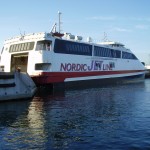 impressive with an equally impressive name, a 60m long car-carrying catamaran called a Kvaerner Fjellstrand 60m JumboCat. The crossing time is about 1¾ hours, and they only operate from May to November because they cannot cope with the ice floating around in the Baltic in the winter. For foot passengers the cheapest fare is about £32 return.
impressive with an equally impressive name, a 60m long car-carrying catamaran called a Kvaerner Fjellstrand 60m JumboCat. The crossing time is about 1¾ hours, and they only operate from May to November because they cannot cope with the ice floating around in the Baltic in the winter. For foot passengers the cheapest fare is about £32 return.
The harbour is actually very busy, because it is the main crossing point between the Baltic States and Scandinavia. There are several fast ferries and numerous conventional ones. The most frequent services are to Helsinki, but there are others to St.Petersburg, Kiel and Stockholm.
The weather in Helsinki was very bright, but surprisingly cool for late June, only about 13 - 15ºC. For a capital city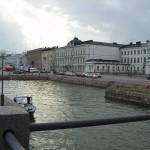 Helsinki is very compact, and you can see all the main sights on foot in a few hours. The harbour area has a line of traditional naval-style buildings along side the quay, and there are many other fine public buildings in the central area, including a huge cathedral. I had a snack in the vast Stockmann store, which was being renovated and most of it was covered with plastic. The railway station was said to be worth a visit, but there were some very peculiar-looking people around there, some like characters from a Nordic saga and others dressed like 19th century explorers. I got the impression that they were not in fancy dress, but just went around like that.
Helsinki is very compact, and you can see all the main sights on foot in a few hours. The harbour area has a line of traditional naval-style buildings along side the quay, and there are many other fine public buildings in the central area, including a huge cathedral. I had a snack in the vast Stockmann store, which was being renovated and most of it was covered with plastic. The railway station was said to be worth a visit, but there were some very peculiar-looking people around there, some like characters from a Nordic saga and others dressed like 19th century explorers. I got the impression that they were not in fancy dress, but just went around like that.
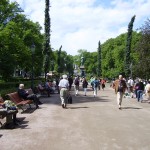 There were a lot of classic cars about, and the city has a motor museum, which I visited. It is in a side street some distance from the centre, and the door was locked when I arrived, but a man saw me trying to get in and unlocked the door. It is a very small museum, with only a few cars, but what is claimed to be the largest collection of models of Mercedes Benz vehicles in the world. There are 5000, so that is probably true.
There were a lot of classic cars about, and the city has a motor museum, which I visited. It is in a side street some distance from the centre, and the door was locked when I arrived, but a man saw me trying to get in and unlocked the door. It is a very small museum, with only a few cars, but what is claimed to be the largest collection of models of Mercedes Benz vehicles in the world. There are 5000, so that is probably true.
In Helsinki everyone can speak English, but signs are not necessarily in English. In one café I could not tell which toilets were which, so I asked some ladies at a nearby table. One of them got up and tapped on the letters of the Finnish word on the door and read them out as if I was a complete idiot not to know that it meant gents. She then sat down and they all had a laugh at my expense.
Most things in Helsinki are much dearer than in England, sometimes by as much as 50%, and it certainly not a place to  go for a shopping spree. I did manage to find an English paperback for €1 in a second hand bookshop.
go for a shopping spree. I did manage to find an English paperback for €1 in a second hand bookshop.
On a bright day at the end of June I think I saw the city at its best, and I can imagine that in the middle of winter, with the short days, long nights and low temperatures it could be quite depressing.
The next morning I got up early and caught the bus to the airport, where I was picking up the car to go to Narva. It was an Opel Corsa from Budget Car Rental, and I was on the road to Narva by 10.00am. From Tallinn to Narva is about 150 miles. It was a straightforward but unpleasant drive, because most of time I was facing into the sun and the Corsa has appalling reflections of the dashboard in the windscreen, making it difficult to see 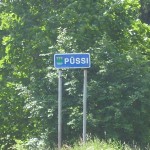 anything in shadow.
anything in shadow.
My interest in Estonia was sparked by a book called FIREWALL by Andy McNab, in which much of the action takes place in the Narva area, including a village called Pussi. Needless to say, this gave rise to a comment from McNab, but when I went to look at Pussi there was nothing much to see.
A few miles before Narva I turned off towards the coast and went up to a seaside resort called Narva-Jõesuu, which is quite old fashioned and undeveloped. It is really like a village, very heavily wooded and with little road access to the beach. On the back roads there was plenty of parking space, but nowhere that I would consider to be safe, and in the areas where it did appear to be safe it was impossible to find a space. There was what looked like a car park with a lady attendant next to a hotel, and when I pulled in she came over to me and I asked her if she spoke English. She had a very broad face, with the widest mouth I have ever seen, displaying about 40 teeth. It seemed that she did not speak English, and when I asked if I could park there she shook her head, and closed her mouth so that her dark red lips formed a thin line about 5in long, as if they were zipped together. It was clear that they were not going to be unzipped again in my presence, so I drove away. That was the most memorable face of 2008.
About ¼ mile further along the road there was another car park with a man in charge, but I got the same sort of reaction, and gave up. I did manage to briefly walk through to the beach, and it appeared to be quite good, with a wide 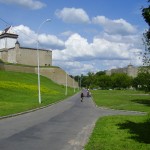 stretch of sand and few people.
stretch of sand and few people.
The road from there into Narva runs alongside the river Narva, with Russia on the opposite bank, and on the approach to the town the road surface disappeared completely for several hundred yards. There was work in progress, but it looked as if it had been like that for a very long time.
The King Hotel, which I had pre-booked on the internet, was easy to find, and perfectly satisfactory. It was an old building, furnished in the traditional style, with a guarded car park at the back. After getting sorted I went for a walk round the town. When Estonia became independent in 1991 the Russia residents were cut off from their homeland and this has led to a lot of problems. 96% of the people in Narva are Russian, and that is the dominant language in the area. Whereas in Tallinn few East European vehicles are to be seen, Narva is still Lada 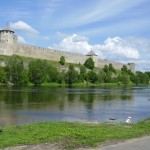 country.
country.
There are few border crossings from Estonia into Russia, and the bridge at Narva is the most important one. The scene from the river bank above the bridge is quite dramatic, with castles high up on both sides of the river, directly facing one another. The bridge down below is straight out of a Cold War movie, with high wire fences on both sides and a gatehouse with barrier on the Russian side. It was easy to imagine spies being exchanged on a foggy night in the winter.
In fact, of course, Narva and Ivangorod, the town on the Russian side, were effectively one town for 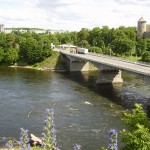 many years until 1991, with freedom of movement between them. The wire fences now extend right back into Narva, with massive customs buildings and holding areas for lorries, with many more waiting along the main road into the town from Tallinn.
many years until 1991, with freedom of movement between them. The wire fences now extend right back into Narva, with massive customs buildings and holding areas for lorries, with many more waiting along the main road into the town from Tallinn.
Much though I would have liked to have crossed over that bridge, it was not possible, because I did not have a Russian visa. For a long time I sat watching the events down below, and it was very much in slow motion. Vehicles were allowed into Ivangorod at the rate of two every half hour, and periodically people would go through on foot. The land border crossings into Russia are notorious for long waiting times, especially for vehicles, and this one is certainly no exception. As far as I could see, there was nothing to stop anyone from swimming across, if they were competent to  do so.
do so.
After an evening meal in the hotel I went for another walk, and discovered the wonderful old town hall, one of the few pre-war buildings left in Narva. The next morning I set off for Tallinn, but diverted to look at Kohtla-Jarva, a former industrial town which has fallen on hard times. In a strange sort of way it was reminiscent of a wild west town, with buildings spaced out along both sides of the wide main street.
The journey back to Tallinn and the flight were uneventful, and I felt that I seen all I wanted to see of Estonia.